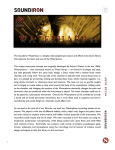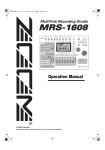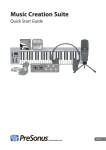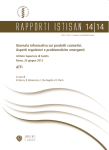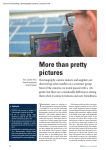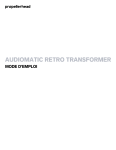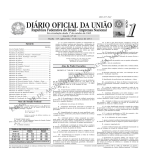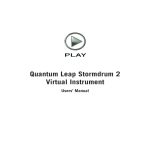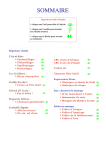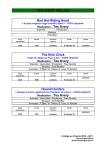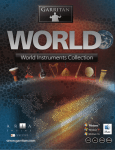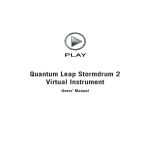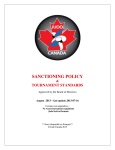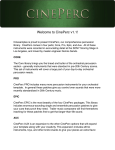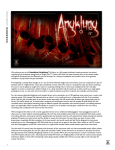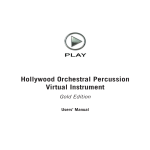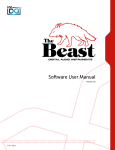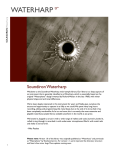Download Quantum Leap Stormdrum 3 Manual - Soundsonline
Transcript
Quantum Leap Stormdrum 3 Virtual Instrument Users’ Manual QUANTUM LEAP STORMDRUM 3 VIRTUAL INSTRUMENT The information in this document is subject to change without notice and does not represent a commitment on the part of East West Sounds, Inc. The software and sounds described in this document are subject to License Agreements and may not be copied to other media. No part of this publication may be copied, reproduced or otherwise transmitted or recorded, for any purpose, without prior written permission by East West Sounds, Inc. All product and company names are ™ or ® trademarks of their respective owners. Solid State Logic (SSL) Channel Strip, Transient Shaper, and Stereo Compressor licensed from Solid State Logic. SSL and Solid State Logic are registered trademarks of Red Lion 49 Ltd. © East West Sounds, Inc., 2013. All rights reserved. East West Sounds, Inc. 6000 Sunset Blvd. Hollywood, CA 90028 USA 1-323-957-6969 voice 1-323-957-6966 fax For questions about licensing of products: [email protected] For more general information about products: [email protected] http://support.soundsonline.com ii QUANTUM LEAP STORMDRUM 3 VIRTUAL INSTRUMENT 1. Welcome 2 About EastWest and Quantum Leap 3 Producer: Nick Phoenix 4 Percussionist: Mickey Hart 5Credits 6 How to Use This and the Other Manuals 7 Online Documentation and Other Resources Click on this text to open the Master Navigation Document 1 QUANTUM LEAP STORMDRUM 3 VIRTUAL INSTRUMENT Welcome About EastWest and Quantum Leap Founder and producer Doug Rogers has over 35 years experience in the audio industry and is the recipient of many recording industry awards including “Recording Engineer of the Year.” In 2005, “The Art of Digital Music” named him one of “56 Visionary Artists & Insiders” in the book of the same name. In 1988, he founded EastWest, the most critically acclaimed sound developer in the world, and recipient of over 60 industry awards, more than any other sound developer. His uncompromising approach to quality, and innovative ideas have enabled EastWest/Quantum Leap to lead the sound-ware business for 25 years. In 1997 Rogers partnered with producer/composer Nick Phoenix and set up the Quantum Leap imprint, a wholly owned division of EastWest, to produce high-quality, no-compromise sample libraries and virtual instruments. Quantum Leap virtual instruments are mostly produced by Nick Phoenix. Some of the larger productions, such as Symphonic Orchestra, Symphonic Choirs, Pianos, and the Hollywood Orchestral Series are co-produced by Doug Rogers and Nick Phoenix. As a composer, Phoenix began scoring film trailers and television commercials in 1994. To date, he has either scored or licensed music for the ad campaigns of over 1000 major motion pictures including Tomb Raider 2, Terminator 3, Lord of the Rings Return of the King, Harry Potter 2, Star Wars Episode 2, Spiderman 3, Pirates of the Caribbean 3, Blood Diamond, Night at the Museum, and The Da Vinci Code. EastWest/Quantum Leap has now firmly established itself as one of the world’s top producers of high-end sample libraries and virtual instruments. In 2006, EastWest purchased the legendary Cello Studios (formerly United Western Recorders) on Sunset Boulevard in Hollywood, re-naming it EastWest Studios. The 21,000 sq. ft. facility, since remodeled by master designer Philippe Starck, houses five recording studios and is the world headquarters for EastWest. Chapter 1: Welcome 2 QUANTUM LEAP STORMDRUM 3 VIRTUAL INSTRUMENT Producer: Nick Phoenix Nick founded Quantum Leap and, apart from the co-productions with Doug Rogers, has produced all its titles. “I am a sample maniac. Working as a composer has given me a unique perspective into what composers really need.” Nick has been scoring and creating the music for film trailers for the past 19 years. His company “Two Steps From Hell” is the top trailer music company in the world. Two Steps albums are consistently in the top 100 on iTunes, and the first album is about to go Gold. Two Steps From Hell gave its first concert at Walt Disney Concert Hall in June 2013. Chapter 1: Welcome 3 QUANTUM LEAP STORMDRUM 3 VIRTUAL INSTRUMENT Percussionist: Mickey Hart Mickey Hart is best known for his nearly three decades as an integral part of an extraordinary expedition into the soul and spirit of music, disguised as the rock and roll band the Grateful Dead. As half of the percussion tandem known as the Rhythm Devils, Mickey and Bill Kreutzmann transcended the conventions of rock drumming. Their extended poly-rhythmic excursions were highlights of Grateful Dead shows, introducing the band’s audience to an ever-growing arsenal of percussion instruments from around the world. Exposure to these exotic sounds fueled Mickey’s desire to learn about the various cultures that produced them. His tireless study of the world’s music led Mickey to many great teachers and collaborators, including his partners in Planet Drum Zakir Hussain, Babatunde Olatunji, and Airto Moreira. Planet Drum’s self-titled album not only hit #1 on the Billboard World Music Chart, remaining there for 26 weeks, it also received the Grammy for Best World Music Album in 1991—the first Grammy ever awarded in this category. Hart took home the Grammy for Best Contemporary World Music Album in 2007 for the Global Drum Project with Zakir Hussain, Sikiru Adepoju, and Giovanni Hidalgo. He released his latest critically acclaimed album, Mysterium Tremendum, in 2012. Chapter 1: Welcome 4 QUANTUM LEAP STORMDRUM 3 VIRTUAL INSTRUMENT Credits Producer Nick Phoenix Executive Producer Doug Rogers Project Coordination Doug Rogers, Rhys Moody, and Nick Phoenix Engineers Nick Phoenix, Ken Sluiter, Jeremy Miller Percussionists Mickey Hart, Nick Phoenix, Chalo Eduardo, Greg Ellis Editing and Programming Justin Harris, Nick Phoenix, Mike DiMattia, Andrzej Warzocha, Jason Coffman, Pierre Martin, Arne Schulze Art Direction Steven Gilmore, Thomas Merkle, Doug Rogers, Nick Phoenix, Rhys Moody Software Klaus Lebkücher, Klaus Voltmer, Bartlomiej Bazior, Adam Higerd, Truc Phan, Stefan Holek, Doug Rogers, Nick Phoenix, Rhys Moody, Elon Arbiture, Helen Evans Manual John Philpit Special Thanks Remo Chapter 1: Welcome 5 QUANTUM LEAP STORMDRUM 3 VIRTUAL INSTRUMENT How to Use This and the Other Manuals All documentation for the EastWest PLAY Advanced Sample System and its libraries is provided as a collection of Adobe Acrobat files, also called PDFs. They can be viewed on the computer screen or printed to paper. Each time you install one of the PLAY System libraries, two manuals are copied to the file system on your computer: • The manual that describes the whole PLAY System. The largest of the manuals, it addresses how to install and use all aspects of the software that are common to all libraries. • The library-specific manual, such as the one you are currently reading. This smaller document describes aspects that differ from one library to the next, such as the list of included instruments and articulations. Using the Adobe Acrobat Features By opening the Bookmarks pane along the left edge of the Adobe Acrobat Reader, the user can jump directly to a topic from the section names. Note that some older versions of Acrobat Reader might not support all these features. The latest Acrobat Reader can be downloaded and installed at no cost from the Adobe web site. (As an example of a hyperlink, you can click on the last word of the previous sentence to be taken directly to the Adobe site.) When reading this and other manuals on the computer screen, you can zoom in to see more detail in the images or zoom out to see more of the page at once. If an included picture of the user interface, or a diagram, seems fuzzy or illegible, then zoom in using one of several means provided in the Acrobat Reader software. The Master Navigation Document Because the EastWest PLAY System is a collection of components, each with its own User’s Manual, a Master Navigation Document (MND) is provided to allow users to jump quickly between these PDFs when being read on the computer screen. This MND is a one-page file with hyperlinks to the PLAY System documentation and to all the library manuals. Hyperlinks to this Master Navigation Document are found on the title page of each chapter in each document. From there, you can open any other document in the collection. For example, if you’re reading something in this documentation for the Quantum Leap Stormdrum 3 library, and need to open the manual for the PLAY System as well, go to any chapter title page and click on the link that says, “Click on this text to open the Master Navigation Document.” It will open in a new window on the screen. In that document, click on the icon for the PLAY System and its manual will open in the same window (hiding the MND). You now have both the SD3 library manual and the PLAY System manual open in separate windows so you can refer to them both. Chapter 1: Welcome 6 QUANTUM LEAP STORMDRUM 3 VIRTUAL INSTRUMENT Online Documentation and Other Resources For the most up to date information, visit the support pages at EastWest’s web site. There you can find: • information made available after these manuals were written • FAQ pages that may already list answers to questions you have • suggestions from EastWest and other users of the EastWest PLAY System • news about upcoming releases The address is: World excluding Europe: http://support.soundsonline.com Europe: http://support.soundsonline-europe.com You can also visit the EastWest online forums. There you can read comments and questions from others who use EastWest products and post your own. The many forum participants are a good source of helpful information about both the technical and musical aspects of this software. The address of the forums is: http://www.soundsonline-forums.com Chapter 1: Welcome 7 QUANTUM LEAP STORMDRUM 3 VIRTUAL INSTRUMENT 2. Quantum Leap Stormdrum 3, An Overview 9 10 12 12 The Design Concept For the Stormdrum 3 Virtual Instrument Statement from the Producer What’s Included Hardware Requirements Click on this text to open the Master Navigation Document 8 QUANTUM LEAP STORMDRUM 3 VIRTUAL INSTRUMENT Quantum Leap Stormdrum 3, An Overview The Design Concept For the Stormdrum 3 Virtual Instrument More than 5 years after the release of “Quantum Leap SD2 – The Next Generation,” the Producer of that award-winning virtual instrument, Nick Phoenix, is releasing an all new collection of percussion instruments, Quantum Leap SD3. Not only has he newly recorded a vast array of both common and unusual sounds, but he has taken advantage of the superior technical capabilities of today’s recording studio to create a library with an inspiring sonic presence. This percussion library was recorded in the same location, EastWest Studios in Hollywood, California, as the 3 titles from the Hollywood series by EastWest/Quantum Leap: Strings, Brass, and Woodwinds. Therefore, all these libraries work together to provide a consistent sound quality. And like the Diamond Editions of those earlier “Hollywood” libraries, it includes samples simultaneously recorded with 5 sets of microphones that you can mix together in the PLAY software to achieve the sonic presence you require, from close and intimate to expansive. More information about the microphone options is included on page 51. To achieve the breadth of instrument types Nick Phoenix was looking for in his new library, he drew on the private collection of legendary percussionist Mickey Hart and multiple drums on loan from the Remo company, hand-picked by drum pioneer Remo himself. Nick Phoenix, Mickey Hart, and Remo in the control room at EastWest Studios. Chapter 2: Quantum Leap Stormdrum 3, An Overview 9 QUANTUM LEAP STORMDRUM 3 VIRTUAL INSTRUMENT The SD3 library is not exclusively about unusual instrumentation. It features some of the most naturally played and realistically recorded standard percussion available. This includes such instruments as bongos, tabla, doumbek, cajon and djembe. One of the favorite instrument groups in SD2 has been the taiko drums. This new library features a wholly new assortment of these sometimes huge Japanese marvels, the most comprehensive, authentic and awe-inspiring group of taiko drums ever sampled. Remo, Chalo Eduardo, and Mickey Hart set up one of the larger Remo drums. The SD3 virtual instrument includes not only individual sampled instruments, but also tempo-synced percussion performances directed and played by Mickey Hart, along with Chalo Eduardo, and Nick Phoenix. They are multi-instrument, looped snippets from 23 different jams. As an example, one of these jam sessions called Sambastique has been carved into 40 unique snippets at a consistent tempo that can be arranged in any order you want. Read more about these performance loops in the section called The Mickey Hart Live Loops Folder, starting on page 48. Statement from the Producer “As a lifelong Grateful Dead fan and a percussion fanatic, it was a dream to create a virtual instrument with Mickey Hart. The incredible and oftentimes unique sounds in Quantum Leap Stormdrum 3 will inspire composers for decades to come. SD3 follows the general blueprint of SD2, in that it has acoustic percussion multi-samples in the following categories: Large Drums, Small Drums, Metals, Woods, Shakers and the Taiko Family, but the similarities end there. SD3 has more extensive techniques, more round robins, 5 separate mic positions, better instruments, better execution and performance, and even more magic than SD2. It also has the biggest and most authentic taiko col- Chapter 2: Quantum Leap Stormdrum 3, An Overview 10 QUANTUM LEAP STORMDRUM 3 VIRTUAL INSTRUMENT lection ever sampled. Everything from piercing tones of a small shime daiko, to deep ensembles, to an 800-pound (360-kilo) monster taiko. “At the end of the recording session, we spent half of a day laying down some mean four-man grooves. Playing with Mickey was like taking peyote and jumping on a quasar. These performances represent a bonus section in SD3 controlled by excellent time compression and expansion. In SD3, our focus was to capture Mickey’s unrivaled percussion collection in the best possible multi-sampled way. It is very flexible. And note that even the close mix comprises the input from 8 microphones. “This virtual instrument is his legacy, and mine as well. After the sessions, Mickey told me I was a maniac and that he knows one when he sees one. I’m proud of that.” — Nick Phoenix Jamming in EastWest Studio 1: Nick, Mickey, Chalo, lots of percussion, and lots of mics. Chapter 2: Quantum Leap Stormdrum 3, An Overview 11 QUANTUM LEAP STORMDRUM 3 VIRTUAL INSTRUMENT What’s Included This Quantum Leap Stormdrum 3 library you purchased includes all of the following: • a complete set of sample-based instruments, enumerated later in this manual • approximately 87 Gigabytes of 24-bit, 44.1 kHz samples • the EastWest PLAY Advanced Sample Engine • the unique authorization code that identifies the license you bought • manuals in Adobe Acrobat format for both the EastWest PLAY System and the Quantum Leap Stormdrum 3 Virtual Instrument • an installation program to set up the library, software, and documentation on your computer • an Authorization Wizard for registering your license in an online database One required item not usually included is an iLok security key. If you already have one from an earlier purchase of software, you can use it. Otherwise, you need to acquire one. They are available from many retailers that sell EastWest and Quantum Leap products, or you can buy one online at www.soundsonline.com. Hardware Requirements See the PLAY System manual for a complete list of the Hardware and Software Requirements for installing and running any PLAY System library. In addition, the available space on the hard drive required for a full installation of Quantum Leap Stormdrum 3 is approximately 87 GB (Gigabytes). Chapter 2: Quantum Leap Stormdrum 3, An Overview 12 QUANTUM LEAP STORMDRUM 3 VIRTUAL INSTRUMENT 3. The Quantum Leap Stormdrum 3 User Interface 15 Round Robin Reset Button 15 Stereo Spread 16 Filter Controls 16 Reverb Controls 16 Time-Stretch Tuning 17Sensitivity 17 The Graphical Representation of the Envelope 18 The Browser View 18 The Mixer View 19 FX Plug-ins in the Mixer View 28 MIDI Control Codes in Stormdrum 3 29 The 6-Pole Filter Click on this text to open the Master Navigation Document 13 QUANTUM LEAP STORMDRUM 3 VIRTUAL INSTRUMENT The Quantum Leap Stormdrum 3 User Interface Overview of the User Interface Each library presents its own interface when one of its instruments is the current one, as specified in the Instruments drop-down in the upper right corner. The image below provides an overview of the entire window when in Player View. Chapter 3: The Quantum Leap Stormdrum 3 User Interface 14 QUANTUM LEAP STORMDRUM 3 VIRTUAL INSTRUMENT Much of this interface is shared by all PLAY System libraries, and the common features are described in the PLAY System manual. The 6 controls described here are: • Round Robin Reset • Stereo Spread • Filter • Reverb • Sensitivity • the graphical representation of the Envelope Round Robin Reset Button A round robin articulation is one in which several different samples are recorded with all parameters, such as volume, speed of attack, and so on, being essentially constant. The PLAY Engine then knows to alternate between the two or more samples during playback. The goal is to avoid what’s often called the “machine gun effect,” in which playing the same sampled note repeatedly causes the unnatural sound of consecutive notes being mechanically identical. There’s one potential problem with round robin technology, and one way to solve it is the Round Robin Reset button. The PLAY Engine remembers which sample should be played the next time the note sounds. If, for example, a round-robin patch contains two samples, A and B, and a piece uses that note 7 times, the PLAY Engine plays A B A B A B A. If the piece is played again from the beginning, the engine will play starting with B, because that’s next in order. The second rendition will be subtly different. Being able to reset all round-robin articulations to the beginning of the cycle allows for consistent playback. You can use this button to reset all round robin instruments on demand. Or use your choice of a MIDI note or MIDI control code to reset them one instrument at a time from a MIDI keyboard or the data stored in a sequencer project. See the description of the Settings dialog for more information about this instrument-specific approach. Stereo Spread The knob in this set of controls affects the apparent width of the sound of the instrument within the soundscape. Turning the knob all the way to the left makes the sound seem to come from a specific location as indicated by the Pan control. The more this knob is turned to the right the wider the apparent source of the sound, making it harder to pinpoint in the stereo field. The Left and Right (L and R) buttons specify the source of the audio input for this control, the left or right channel. Note that you can click either button to change the input to the one currently off. The button titled On must be illuminated for the controls to have any effect. Chapter 3: The Quantum Leap Stormdrum 3 User Interface 15 QUANTUM LEAP STORMDRUM 3 VIRTUAL INSTRUMENT Filter Controls The Filter controls take the sound of the instrument, and modify it by filtering out some of the sound above a certain frequency. This type of effect is commonly called a Low Pass Filter. The Frequency knob determines where the sound starts to be filtered out. (In the image at the right, the frequency is set to 2 kilohertz.) The Resonance knob specifies how much the filter “rings” at the dialed frequency. The higher the resonance knob is set, the more focused this ringing becomes. The graph gives you visual cues about the frequency distribution you are creating with the settings you select. Make sure the On button is illuminated for this filter to have any effect. Reverb Controls A generic Reverb control is described in the main PLAY manual, and that description applies here as well. The Reverb controls in Stormdrum 3 contains an extra knob not present in some other PLAY interfaces: Pre-Delay Increasing the level with this knob delays the onset of the reverb so that the initial section of the sample is unaffected. This feature allows the sound of each attack to maintain its true color while the rest of the note still gains the benefit of the reverb effect. Time-Stretch Tuning This set of controls allows you to control the pitch, either with or without also changing the tempo of a performance, depending on multiple factors, as described below. There are three related controls. One is a knob for raising or lowering the pitch. Then there’s a pair of buttons (Tune A, Tune B)for selecting which of two kinds of re-tuning you want to use. The third control is a switch for selecting the quality. • On the left is option A, the original EastWest tuning approach. With Button A, you’re changing the speed of playback in order to affect the pitch. But, if you use Button A with a performance from the Live Loops folder, the tempo is not affected; that’s because the tempo of those performances is controlled by the host’s tempo setting (or when running in standalone mode, by the Engine Tempo Sync setting in the Advanced Chapter 3: The Quantum Leap Stormdrum 3 User Interface 16 QUANTUM LEAP STORMDRUM 3 VIRTUAL INSTRUMENT Instrument Properties from the Main Menu). In the Live Loops folder, this Tune A option only changes the pitch. • With Button B, the playback speed remains unchanged, even as the output is retuned. And that’s consistent across all folders. In other words, in most folders, the A and B approaches are very different. But in the Live Loops folder, the basic effect will be about the same either way, though the timbre of the instrument may sound a little different depending on whether you select A or B. There’s also a switch to choose between two modes: Normal and High Quality (labeled N and H, respectively). Normal Quality is the default, and you should only consider changing to the High Quality setting if you’re running PLAY on a more capable computer with enough processing power to handle the extra computations required to achieve this extra level of quality. Note that this selection of Quality applies to the B Tuning option for all instruments and to the A Tuning option only for loops (such as those in the Mickey hart Live Loops folder), because loops always use time-stretching. Sensitivity This control defines a mapping between the velocity of the MIDI notes and the velocity of the notes that sound. Being able to control the sensitivity is primarily useful when playing live, for example on a keyboard or drum pad. For example, suppose you want to play notes at the high end of the velocity range (maybe 80 to 120, out of 127) for some instrument, but find it difficult to play the keyboard in a way that lets you consistently play the sounds you want. Drag up with the mouse over the Sensitivity graph so the graph looks like the picture at the left. A medium touch on the keyboard sounds louder than it would otherwise and a wider range of touches will all generate sounds in the louder range you want. Conversely, drag the graph downward to gain more control over the lower half of the velocity range. The Graphical Representation of the Envelope The Envelope Controls are described in the main PLAY System manual because they are common to all PLAY System libraries. Only some libraries include the graph, as shown here, so it is included in the manuals for those libraries only. Note that the total width of the graph represents the total length of all phases of the envelope. Therefore, when you change something in one part of the graph, for example, the decay, you may see the slopes of other components, the Chapter 3: The Quantum Leap Stormdrum 3 User Interface 17 QUANTUM LEAP STORMDRUM 3 VIRTUAL INSTRUMENT attack and the release, change as well because those phases become a larger or smaller percent of the whole; this is as expected. The Browser View The Browser behaves identically among all PLAY System libraries. Read the main PLAY System manual for information about how to use that view. The Mixer View The Mixer view is new in PLAY 4. As described in the PLAY 4 manual, the Mixer view allows the user to view and control the output from all the channels within the current instance of PLAY. Here, you can control the loudness and the pan position, as well as the MIDI input and the audio output channel. You can also mute or solo each track (the M button or S button, respectively). In any PLAY virtual instrument that features multiple microphone positions, it is also possible to mix and blend the output from those mics. The image above shows the PLAY mixer page with the Stormdrum 3 instrument named 36in Thai Gong Hits loaded into the left-most column. At the top, “Channel 1” means that it responds to MIDI input on channel 1 only. And where the MIDI input for the other instrument reads “Omni,” that means it responds to all MIDI channels. Click in this control to see a list of other input options you can select. Chapter 3: The Quantum Leap Stormdrum 3 User Interface 18 QUANTUM LEAP STORMDRUM 3 VIRTUAL INSTRUMENT The small button with the fader symbol lit in yellow has been pressed to open 5 more strips to the right, representing the 5 mics available in SD3. (Clicking on the yellow button again hides the mic strips so that you can see more channel strips, but any values you set still apply when the strips are hidden.) The name of each mic is listed at the bottom. In the image above, the Close and Hi-Fi buttons are lit in white to indicate that those samples are loaded in memory and the mics are currently active. To load or unload the samples from memory, click on the button for that mic position. The meter and slider for each instrument or mic represents the current output level for that audio channel. The Pan knob at the top of each strip moves the apparent position of the instrument left or right within the stereo field. And note that you can pan the individual mics separately. At the very top of a mic strip is another knob marked REV SND (which stands for Reverb Send) that allows you to indicate how much of the sound from this mic to direct to the currently selected reverb. The REV SND control applies a second gain to the signal going to the Reverb, allowing you to send up to 12 dB more to the Reverb than to the standard output, or to reduce the signal as much as 60 dB. In other words, both the gain from the strip’s vertical fader and the gain from the REV SND knob are applied together to the signal going to the PLAY Reverb. This approach maintains a consistent ratio between the strength of the main and reverb outputs. At the very bottom, just above a horizontal scrollbar (which is only visible when the channels strips together are wider than the width of the window), is a drop-down list labeled Output. This control allows you to select which of the 9 stereo pairs of audio buses should receive the output. • For an instrument strip, the default is Main L/R, the first pair—and in many projects the only pair used. Click on the control to open a list of other options. • For a mic strip, the Default setting directs the audio to the output for its instrument strip (immediately to the left of the 5 mic strips). Selecting any of the other pairs directs the output to a different bus pair. You would likely want to select anything other than Default only if you want to do mixing of the individual mic signals in a mixing board or mixing program external to PLAY. FX Plug-ins in the Mixer View Stormdrum 3 and PLAY 4 include a collection of FX processors licensed from Solid State Logic (SSL), plus a Reverb from EastWest. They can be used to modify the audio output for either any specific instrument or any specific mic position for the instrument. To open the plug-in UI for an instrument, first change to the Mixer view, then click on the FX button in the channel strip for that instrument. To open the plug-in UI for a single mic position, click on the FX button in that mic’s strip. The controls for the plug-ins sit on top of the channel strips in what’s called a “drawer.” Note that the bottoms of the channel strips are still visible below the FX drawer, as in the image that follows. Chapter 3: The Quantum Leap Stormdrum 3 User Interface 19 QUANTUM LEAP STORMDRUM 3 VIRTUAL INSTRUMENT The image above shows the full set of plug-ins for the instrument loaded into the second instrument strip (Acapulco 115 BPM). At the bottom of the drawer are 2 controls: a Preset list (which is empty in the image) and a Channel list, where you can use the left and right arrow buttons to move to a different strip, including to a mic strip that is currently hidden. Using this Channel list, you can move through the various strips without having to close one drawer and open another. Included in the FX drawer are: • an EQ & Dynamics plug-in, consisting of: »» a Filter »» an EQ »» a Compressor and Noise Gate/Expander • a Transient Shaper plug-in • a Convolution Reverb plug-in. This plug-in is available only on channel strips, not mic strips. • a Stereo Compressor plug-in. This plug-in is available only on channel strips, not mic strips. The specific controls are described in detail after this overview. To hide the UI for all the plug-ins, click on the X button in the lower right corner. The settings are preserved while the controls are hidden, with the saved values reappearing when they are reopened with the FX button. Chapter 3: The Quantum Leap Stormdrum 3 User Interface 20 QUANTUM LEAP STORMDRUM 3 VIRTUAL INSTRUMENT The following image shows the plug-ins that appear when the FX button is clicked in a mic strip. Only the plug-ins in the top section of the image above are available for the audio output from a single mic. This image shows the plug-ins for the Close mic, as indicated in the Channel drop-down list in the lower right. SSL’s EQ & Dynamics Channel Strip Plug-in (both Instrument and Mic Plug-in) This plug-in passes the signal through 5 separate sections, as described separately in the text below. Input Section and Output Section Turn the Gain knob in the Input Section to control the level of the incoming audio signal. The post-gain signal level is shown in lights to its left. As a rough guide, the ‘-6’ yellow indicator should occasionally comes on but the red ‘0’ indicator should remain off. Press the Ø button to invert the phase of the input signal. The Output Section is the last step in the processing. The Gain knob controls the audio level of the output signal. Adjust this level last to achieve the loudness of the signal that you want. The same rules for the yellow and red indicator lights apply here as in the Input Section. The S/C Listen button directs the Dynamics Side Chain to the channel output. Filter Section The Filter controls provide access to two separate kinds of filters. The black knob controls an 18dB/Octave high-pass filter (20Hz to 500Hz). Use it to remove lower frequencies from the audio. The purple knob controls a 12dB/Octave low-pass filter (3kHz to 22kHz). Use it to remove higher frequencies. Turn either knob fully left (marked OUT) to turn that filter off. Turn either one (or both) clockwise to move the filter frequency in from its extremity. Chapter 3: The Quantum Leap Stormdrum 3 User Interface 21 QUANTUM LEAP STORMDRUM 3 VIRTUAL INSTRUMENT You have a choice where to insert the Filters in the audio stream. To place the Filters immediately following the Input control, press the Input button. To switch the Filters into the Dynamics Side Chain, press the Dyn S/C button. Note that when the Dyn S/C button is engaged the Input button has no effect. Equalizer Section To use the EQ, switch it into circuit by pressing the EQ In button, which is near the top in the center of the UI for this section. The EQ section has four bands, each with its own knob color. All bands have gain and frequency control. The low (LF) and high (HF) bands are shelved by default but can be switched to a bell shape (parametric) by pressing the Bell button; the Bell option gives you more control over the exact shape of the EQ curve. The low-mid (LMF) and high-mid (HMF) bands have Q controls (to adjust the sharpness of the modified curve) in addition to what the others have. Listed in the table below are the ranges for the knobs in each section. Band Frequency range Gain range Q range LF LMF HMF HF 40Hz – 600Hz 200Hz – 2kHz 600Hz – 7kHz 1.5kHz – 22kHz ±16.5dB ±20dB ±20dB ±20dB — 0.5 – 2.5 0.5 – 2.5 — The E button in the center toggles the EQ emulation between the G Series and E Series consoles. The difference between them is described in the following table. G Series E Series The bell curve has a more rounded shape at low gains, and the shelf curve overshoots zero slightly at the base of the curve. The bell curve is slightly more pointed, and there is no overshoot on the shelf curve. G Series EQ is more subtle and is generally more suited to instruments and vocals. E Series EQ is more aggressive and is therefore better for removing problem frequencies. It is generally more suited to drums. Note: At full boost or full cut, the E and G Series curves are identical. To switch the EQ into the Dynamics Side Chain, press Dyn SC. Dynamics Section This section consists of both Compressor controls and Noise Gate/Expander controls. Both sections work independently but can be operational at the same time, providing Chapter 3: The Quantum Leap Stormdrum 3 User Interface 22 QUANTUM LEAP STORMDRUM 3 VIRTUAL INSTRUMENT sophisticated control of signal levels. The example image of the UI is shown below, after the description of the Compressor. There are two buttons at the top. The Dyn In button turns on the whole section. The Pre EQ button moves this section before the Equalizer; otherwise, this processing is performed after the Equalizer. Compressor: On the left are 3 blue knobs for controlling the Compressor: Threshold, Release, and Ratio. To activate the Compressor/Limiter, turn the Ratio knob so that its ratio is no longer set at 1:1. To turn the compressor into a ∞:1 limiter, turn the knob fully to the right. There is no gain makeup control because the T/HOLD (threshold) knob controls both the level at which gain reduction is introduced and the gain make-up, thus keeping the output level steady regardless of the compression. The Release knob controls how quickly the level returns to normal after the input level has dropped below the threshold (measured in seconds). The attack time is adjusted automatically to match the audio. To choose a consistently fast attack time, press the Fast Att button. Turn on the PK button to switch from RMS to Peak signal detection. In normal RMS mode, the compressor reacts to the average signal level and has a soft knee characteristic. When switched to Peak mode, it responds to peak signal level and introduces a hard knee characteristic, resulting in more dramatic compression. The level of compression being introduced is shown in the left-hand of the two meters in the centre of the Dynamics section. Noise Gate/Expander: To activate the Noise Gate/Expander, turn the Range knob so that its range is no longer zero. The green indicators in the right-hand of the two meters in the centre of the Dynamics section show the amount of gain reduction being introduced. By default, the Noise Gate/Expander section functions as a Gate. To switch to the Expander, press the Exp switch. The Threshold function uses different levels to open the gate to audio and to close it again: the level at which the expander opens is higher than the level at which it closes again. In other words, when the expander is opened, it stays open until the signal level crosses the quieter Close threshold. This is known as hysteresis and is very useful as it allows instruments to decay more naturally. The word “Threshold” normally refers to the Open threshold. Chapter 3: The Quantum Leap Stormdrum 3 User Interface 23 QUANTUM LEAP STORMDRUM 3 VIRTUAL INSTRUMENT The Hold knob controls the delay before the signal level starts reducing again. The Release knob controls how quickly the level then reduces. Note that the Release knob interacts with the Range knob, which determines the depth of gain reduction. The Attack Time (the time taken for the Expander/Gate to ‘recover’ once the signal level is above the ‘deactivate’ threshold) is normally set to 1.5ms per 40dB. Press the Fast Att button to introduce a faster attack time of 100μs per 40dB. This is useful when gating signals with a steep rising edge, such as drums. Processing Order The graphic at the right shows the 8 possible orderings for the 3 processing stages, with and without a Side Chain. The original audio signal starts at the left and the processed signal exits at the right of each diagram. The lower (straight) line is the standard audio path. When the EQ and/or Filter is in the upper path, then that component is in the Side Chain (as described below). The one of these 8 diagrams currently in effect appears in the upper-right corner of the drawer. The default order is Filter >> EQ >> Dynamics, with nothing in the Side Chain, as shown in the 5th diagram in the image. To place the Filter section after the EQ section, deactivate the Input button in the Filter section so that its light is off. To place the Dynamics before the EQ, press the Pre EQ button in the Dynamics section, so that its light is on. When the Input and Pre EQ switch are active simultaneously, the processing order becomes Filter >> Dynamics >> EQ. The Side Chain The Side Chain is a path for the audio signal that is used to control the Dynamics section when it acts on the main audio signal. The Side Chain is not normally audible, but can highlight aspects of the audible signal that need processing. The EQ and Filter sections can be assigned to the Dynamics Side Chain, allowing for advanced processes like de-essing, as described below. This is done using the Dyn S/C switches in the respective sections. Both EQ and Filter sections can be assigned to the Side Chain together, in which case the EQ precedes the Filter. Here’s an example of using the Side Chain to remove the hissing sound of the letter S when it’s too prominent. First, the audio is split into 2 signals. EQ is applied to the signal in the Side Chain to make the hisses louder, so that the compressor can use the louder S sounds as a clue that the main signal needs to be compressed (made softer) at those moments more than at other moments. In the main signal, the S sounds are made softer. Chapter 3: The Quantum Leap Stormdrum 3 User Interface 24 QUANTUM LEAP STORMDRUM 3 VIRTUAL INSTRUMENT To listen to the signal feeding the Side Chain, press the S/C Listen button in the Output section to route the Side Chain signal to the channel output. It is important to remember to cancel the S/C Listen button once you have finished auditioning the Side Chain! SSL’s Transient Shaper Plug-in (both Instrument and Mic Plug-in) The Transient Shaper allows you to augment the attack at the start of a drum hit (or any note) by increasing the amplitude of the attack portion of the signal while leaving the decay and held note unchanged. In the image at the right, the right hand waveform is a processed version of the one on the left. It has been passed through the Transient Shaper where the amplitude of the attack portion has been increased. Switch the Shaper on by clicking on the Power button in its top left-hand corner. The lights at the right give visual feedback on how much attack is being added using the Gain and Amount controls. If the top red light illuminates, reduce the effect. The Gain knob controls the detection level of the controller signal, and should be set so that only the transients you want to shape are detected. If this is set too low then the Shaper will do nothing; if it is set too high then the Shaper will detect too many transients, resulting in an exaggerated process, and the attack appearing too long. The default setting of 0dB should be a good starting point. Note that the Gain setting here does not directly affect the output signal’s gain. Amount controls the amount of the processed signal added to the unprocessed signal. This process can increase the peak level of a signal significantly, so watch the output meter carefully. Speed controls the length of time the added attack takes to fall back down to the normal signal level once it has reached the top of the attack phase. Turn the knob clockwise for a slower speed, and longer transients. The Inv button inverts the processed signal so that it is subtracted from the unprocessed signal. This has the effect of softening the attack, resulting in more body in the drum sound. Press the Audition button to listen to the processed signal to assist in the setup process. Note that when the Inv and Audition buttons are both pressed, the signal is not inverted. Chapter 3: The Quantum Leap Stormdrum 3 User Interface 25 QUANTUM LEAP STORMDRUM 3 VIRTUAL INSTRUMENT EastWest Convolution Reverb (Instrument Plug-in only) This Convolution Reverb is an extension of the one in the Player view. It adds some features that are not part of the Player page Reverb: • the ability to load true stereo reverbs • a high-pass and low pass filter set, with 2 handles on the graph for modifying the filters visually • a mono button • additional reverb environments that are not available on the Player page Reverb To include a reverb effect on an instrument, turn it on by clicking on the button in the upper left corner. Or you can also turn it on from the Reverb controls on the Player page. When the button is illuminated, the plug-in is turned on. To add reverb on a specific mic channel, turn up the Reverb Send at the top of that mic’s channel strip. That mic’s signal is then directed into the reverb in the instrument channel. Turn on the Filter for the Convolution Reverb by clicking on the Filter button so that it is illuminated. Then use the two circular handles on the graph to control the frequencies affected by the filter. Drag the handles with the mouse (or with a stylus or finger when a touch-screen provides that capability). The Pre-Delay knob controls the amount of time (if any) that the Reverb effect is delayed after the attack of each note. Postponing the start of the effect allows the attack to sound without processing and to have the reverb affect only the sound of the note as it is held and/or decays. Use your ear to determine how long of a pre-delay works for each instrument. (The Pre-Delay can also be changed with the knob on the Player page.) Use the Reverb drop-down list to select the name of the environment, as shown in the image at the right. This EastWest Convolution Reverb can use true stereo reverbs. The Mono button, when illuminated, indicates that the processing should be performed without separate left and right channels for the IR. The Amount knob controls how much of the effect to include in the output. Drag downward with the mouse to create a more subtle reverb, or drag up Chapter 3: The Quantum Leap Stormdrum 3 User Interface 26 QUANTUM LEAP STORMDRUM 3 VIRTUAL INSTRUMENT to increase the effect. (The Amount can also be changed with the knob on the Player page.) SSL’s Stereo Bus Compressor (Instrument Plug-in only) This is a compressor that works only at the instrument level, not on individual mic channels. This SSL compressor has become legendary in the music industry for its unique sound, so you may want to see how it can improve the sound of your mix. This is a stereo version of the center section stereo bus compressor found on the XL 9000 K Series console. It provides high quality stereo compression, giving you critical control over the dynamic range of audio signals. The compressor UI consists of 1 meter, 5 knobs, and 1 button, as in the image below. Compression This meter shows the real-time gain reduction in decibels (dB). Threshold With this knob you can controls the level at which gain reduction is introduced. The value is continuously variable: –20 dB to +20 dB. Attack This knob controls response time when the Threshold is crossed. Choose among the following times: 0.1, 0.3, 1, 3, 10 and 30 ms. Make-Up This knob selects the level of compensation to offset the compressor’s action. It is continuously variable over the range: –5 dB to +15 dB. Release This control sets how quickly the level returns to normal. Choose between 0.1, 0.3, 0.6, or 1.2 seconds, or you can select Auto. In the case of Auto, the release time is dependent upon the duration of the signal peak. Ratio This knob controls the degree of compression. Choose among the ratios of: 2:1, 4:1, and 20:1. Comp In This button switches the compressor in and out of the signal path. Use this button to do a quick comparison between the compressed and uncompressed signal to judge the effect of the current settings. Chapter 3: The Quantum Leap Stormdrum 3 User Interface 27 QUANTUM LEAP STORMDRUM 3 VIRTUAL INSTRUMENT The Preset Control In the bottom-left corner of the plug-in drawer is a dropdown list labeled Preset. Once you have set the values of the controls in a configuration you might want to use again, you can click on the drop-down list and select Save Preset. Then provide a name for that preset. Later on, when you want to set all controls to the saved configuration, select the named preset from the drop-down list. MIDI Control Codes in Stormdrum 3 This library uses special behavior for MIDI control codes compared to some other PLAY libraries. The reason for this difference is that some users will want to select up to 16 Stormdrum 3 instruments to create a kind of ad hoc drum kit with a single PLAY instance and trigger all the notes within a single track in the sequencer. This difference between global and instrument-level control codes was first introduced in Stormdrum 2. Individual SD3 instruments within an instance of PLAY respond independently to CC11 and CC12 messages to affect the loudness and the pan position, respectively. This is in contrast to CC7 and CC10, which affect the loudness and pan of all notes in the track. Instrument-level Panning Control Let’s say you load 3 instruments into one instance of PLAY inside a sequencer or other DAW—a Gourd Drum, an Agogo, and a Log Drum—and assign them to MIDI channels 1, 2, and 3 within PLAY. Assign the gourd drum notes to channel 1, the agogo notes to channel 2, and the log drum notes to channel 3. (Check your sequencer’s documentation if not sure how to do that.) Continuing that example, say you want to simulate the agogo player walking back and forth across the stage. Set up an envelope on the track (or physical slider/knob, if performing live into the sequencer) and assign it to MIDI channel 2 (the agogo) and control code 12 (individual pan position). As the value of that control code changes, it affects the pan position of the agogo without affecting the 2 drums in the same track. If you had used the standard control code for panning, CC10, all three drums would have moved together. Instrument-level Volume Control It is likewise possible to control the dynamics of one SD3 instrument at a time when 2 or more share a single instance of multi-timbral PLAY within the sequencer. Using the same example as above, if you want the log drum to get louder without affecting the gourd drum or the agogo, create an envelope (or slider/knob) and assign it to MIDI channel 3 (log drum) and control code 11 (Expression). As the value of this control code changes, the volume of only the log drums changes, not the gourd drum or the agogo. You can use CC7 to change the dynamics of all three together. Chapter 3: The Quantum Leap Stormdrum 3 User Interface 28 QUANTUM LEAP STORMDRUM 3 VIRTUAL INSTRUMENT Cross Fading of SD3 Drum Rolls Some, but not all, SD3 drum rolls have pairs of recordings that differ mostly in their loudness and can work together in an effective dynamic cross fade. The MIDI control code 2 (CC2) implements this dynamic cross fade (DXF). Increase the value of CC2 to make the drum roll louder, even in the middle of a roll. Here is a list of the instruments that respond to CC2: • Balaphone KS C0-D0 • Balaphone Roll DXF • 14in and 16in Shime Daiko Japan • 20in Okedo • 36in Nagado Head A • 46in 800 lb Nagado Daiko • 48in Hira Darko • 60in Hira Daiko Note that in other PLAY libraries, it is the Mod Wheel (CC1) that gives you access to dynamic cross fades. But in SD3 the Mod Wheel is assigned to the Filter sweep capability. (See a discussion of that feature in the next paragraph.) Also, note that CC2 is usually intended to implement a breath controller. SD3 is replacing that with this implementation of the drum roll cross fades. The 6-Pole Filter In Stormdrum 3, the Mod Wheel (MIDI Control Code 1) engages a 6-pole low-pass filter in order to allow the reduction of the upper frequencies during playback of the samples. The effect is similar to that of the Frequency knob in the Filter control except that it can be modified in real time, including while a note is still playing. For example, you can push the Mod Wheel all the way on, then hold down a note to start playing it almost silently; then pull the Mod Wheel downward to reveal the note (starting with its lowest frequencies) while the note is still held. (This example assumes that the recorded sound lasts long enough to be revealed this way.) In a sequencer, the Mod Wheel can be controlled with an envelope assigned to MIDI CC1 in order to achieve the same effects as using the Mod Wheel on a keyboard or control surface. Chapter 3: The Quantum Leap Stormdrum 3 User Interface 29 QUANTUM LEAP STORMDRUM 3 VIRTUAL INSTRUMENT 4. Instruments 31 The Stormdrum 3 Collections 33 Tables of the Instruments 34 A Quickstart Folder 35 Big Drums 37 Gongs, Clocks, Waterphone 38Metals 42Shakers 43 Small Drums 46 Taiko Family 47Woods 48 The “Mickey Hart Live Loops” Folder Click on this text to open the Master Navigation Document 30 QUANTUM LEAP STORMDRUM 3 VIRTUAL INSTRUMENT Instruments This chapter provides specific information about each of the many instruments in the Stormdrum 3 library. First, the seven collections are briefly described. The main part of this chapter is the seven tables that list all the instruments and the articulations assigned to individual notes. You might want to print out the pages containing these tables as a reference. The chapter also contains a table of abbreviations used in instrument names. The Stormdrum 3 Collections The PLAY System browser lists seven collections of instruments from which an individual instrument file (.ewi) can be selected, as described briefly below. Note that two other folders do not contain more instruments. Instead, one of them, “A Quickstart Folder,” lists some of the producer’s favorite instruments for providing a quick overview when you first get started with SD3. The second of these folders, Mickey Hart Live Loops, contains short, multi-instrument performance loops cut from recorded jam sessions. You can recombine these snippets into your own percussion tracks. These loops are described in more detail starting on page 48. Big Drums: These are the larger drums that do not fall in the Taiko family. Many of them include large, deep, and booming sounds, but others are more complex in nature. There are some real gems in here from Mickey’s magical warehouse of one-of-a-kind hand drums. Highlights in the epic genre here are The Beast, Double Headed Tree Drum, Lord Of Toms Ensemble, and Dragon Ensemble. Gongs Clocks Waterphones: These instruments provide the iconic sounds of several gongs and waterphones, some played underwater! The “Clockworks” patches are the result of Nick’s field recordings in six antique clock shops. Metals: This group includes bells, deep bowls, chimes, and cymbals collected by Mickey on his world travels. Some are well known like the Brazilian berimbau (which is played on a metal wire), others are unusual, such as hammered copper pots and handmade doorstop drums. Chapter 4: Instruments 31 QUANTUM LEAP STORMDRUM 3 VIRTUAL INSTRUMENT Chalo Eduardo plays the berimbau from Brazil, one of the instruments in the Metals folder. Shakers: The instruments in this group include several made from naturally occurring objects, such as snake rattles, seed pods, and deer hoofs, in addition to the more common ganza, modern shakers and Mickeys mighty rainsticks. Playability here is key. Small Drums: Here you’ll find a very large collection of smaller drums. Some have names you’re probably familiar with, such as bongos, frame drums, and tambourines. But there are so many others that will surprise and delight you. Many of the Indian drums in this category are particularly special, such as the tuned tablas and madal. Performance techniques are stellar. Taiko Family: This collection includes taiko drums ranging from huge to small. Many of the sampled instruments came from the collections of Mickey Hart and Remo to create a wide variety of sounds. Others came from the top taiko builders in Japan. They are played both individually and in ensembles. This is the holy grail of taiko samples. Finally! Woods: In this group you’ll hear unpitched sounds from wooden resonators; tuned chromatic instruments, such as a gourd marimba and a balaphone; the mighty gourd drum; a playable redwood tree branch 12 feet long; and wonderful scraped sounds, such as the Thailand frogs. Chapter 4: Instruments 32 QUANTUM LEAP STORMDRUM 3 VIRTUAL INSTRUMENT Nick Phoenix sits next to a waterphone in the foreground as Mickey Hart plays a gourd marimba across the room. Tables of the Instruments The tables of Quantum Leap Stormdrum 3 instruments are grouped into the 7 collections described above. The columns in the tables include (from left to right): • the name of the file, as you’ll see it in the PLAY Browser • the lowest playable note • the number of playable notes • the number of Round Robin samples • some descriptive text about how articulations are assigned to notes Mickey Hart stretches, near some of the instruments recorded in this library. Chapter 4: Instruments 33 QUANTUM LEAP STORMDRUM 3 VIRTUAL INSTRUMENT Unless there is a reason not to do so, C1 (MIDI note 36, two octaves below middle C) was usually selected as the lowest playable note in SD3 instruments. (And all note names in EastWest and Quantum Leap products use the same naming convention where Middle C, MIDI note 60, is know as C3. Other vendors may use different conventions, with Middle C known as C4 or C5.) Generally, only the white keys on the keyboard are used. But when there are more than 52 playable notes in a single patch or the notes form a chromatic scale, the back keys may be used. An asterisk before the number of notes in a patch (for example, *34) means that black keys are playable. The fourth column in the tables specifies the number of Round Robin samples recorded for each note. But be aware that this number usually applies only to the individual articulations, and not to the effects (FX) or the performances. Note that “1” means there are no Round Robin notes. In the right-most column, individual notes and ranges of notes within an instrument are named when there are distinct differences based on technique and/or the part of the instrument being played. No attempt is made to describe or differentiate between note sounds qualitatively; use your ear to determine which sound is most appropriate for your piece. When you are not reading from the tables note that, as a general principle, as the notes go from low to high the sounds range from inside to outside of the instrument, with any special effects and then performances at the upper end of the playable notes. When a range of notes lists multiple articulations, each articulation is assigned to a single note (for example, “C1–E1 = Clack, Low, High”). When a range of notes names a single articulation, every note in that range plays some variant of that articulation (for example, “C2–F2 = Center roll”). When two articulations in a list have a complete description followed by something less complete, assume they share all but the named difference (for example, “Center LH, RH, …”). Some notes are described as “Perf” or Perf FX.” These are either short performances of a few notes or single notes that can be combined into performances. They are not as complete or polished as the performances in the “Mickey Hart Live Loops” folder, so consider these as little extras that might help you build a performance. In a few cases, a tempo is provided (for example 130 bpm); these are patterns of notes in tempo from the given instrument alone. A Quickstart Folder The first folder listed in the Browser is one designed to feature some of the instruments that the Producer thinks are a good introduction to the range of this library. When you’re getting started with Quantum Leap Stormdrum 3, you may want to begin by opening these instrument files and playing with them. Each of these instrument files is also available in another folder, and you should look in the table for the patch’s home group to find its listing. For example, “Chimes Burma” is documented within the Metals table. Chapter 4: Instruments 34 QUANTUM LEAP STORMDRUM 3 VIRTUAL INSTRUMENT Once you’ve explored this introductory folder, take a look at the wide variety of other instruments in the 7 folders grouped by types: • Big Drums • Gongs Clocks Waterphone • Metals • Shakers • Small Drums • Taiko Family • Woods BIG DRUMS African Ceramic Ashiko C1 18 4 C1–A1 = Bass, Bass with scrape, Mute, Mute slap, Rim, Flam; B1–E3 = FX; F3 = Perf Boule Custom C1 12 4 C1–B1 = Bass, Bass with flam, Center 1, Center 2, Edge, Rim, Rim with flam; C2–G2 = Perf Cajon Black Custom C1 43 4 C1–A1 = Bass RH, Center RH, Edge LH, Slap RH, Corner LH, Corner Flam; B1–C2 = velocity-sensitive rolls; D2–B3 = non-velocity rolls; C4-G5 = bass non-velocity rolls; A5–C7 = Perf 140 bpm Cajon Remo C1 38 4 C1–G1 = Bass, Slap, Corner LH, RH, Corner Flam; A2–D4 = Rolls; E4–E6 = Perf 140 bpm Daf Turkey C1 14 4 C1–F1 = Center, Edge, Mute, Slide; G1–B1 = Finger roll; C2–D2 = Short shake; E2–G2 = Long shake; A2–B2 = Perf Dead The Beast FX Rolls C1 35 1 A wide variety of rolls: short to long and soft to dramatically loud. C1–F2= Left rolls; G2–D4 = Center rolls; E4–B5 = Right rolls Dead The Beast Hits N Rolls C1 36 2 C1– C2 (right eye) = Center LH, RH, Off-center RH, FX flam, Mute, Rim LH, RH, Rim flam; D2–G2 = Right rolls; C3–E3 (home plate) = Off-center LH, RH, Center; F3–G3 (center eye) = FX flam, Mute; A3–C4 (left eye) = Rim LH, RH, Rim flam; D4–G4 = Center rolls; C5–G5 (left eye) = Off center LH, RH, Center, Flam, Mute; A5–C6 (small drum) = Rim LH, RH, Rim flam; D6–G6 = Left rolls Djembe 16in Remo C1 30 4 C1–E1 = Bass; F1–G1 = Mute LR; A1–B1 Mute slap; C2–E2 = Open; F2–A2 = Open slap; B1–C2 = Rim; D2–F2 = Bass flam, Open flam, Open slap flam; G2–A2 = Nail scrape; B2–C3 = Finger roll; D3–F3 = Machine gun, FX ocean, FX slides & scratches continued Chapter 4: Instruments 35 QUANTUM LEAP STORMDRUM 3 VIRTUAL INSTRUMENT BIG DRUMS Double Ceramic Drum C1 41 4 C1– B1 = Open RH, Mute double up-down, Open edge RH, Rim RH, Open LH, Rim LH, Open edge LH; C2–A2 = Rolls; B2–G3 = Long rolls; D4–A6 = Perf 130 bpm Double Headed Tree Drum C1 29 4 C1–C2 = Open1, Open 2, Mute 1, Mute 2, Rim 1, Rim 2, Flam 1, Flam 2; D2–F4 = Rolls; G4–C5 = Perf Dragon Ens Hits 1 fullmix C1 *64 1 C1–E6 = Various booming hits, often with multiple instruments played together Dragon Ens Hits 2 fullmix C1 *46 1 C1–A4 = Various booming hits, often with multiple instruments played together Dragon Ens Rolls 1 fullmix C1 *68 1 C1–G6 = Various booming rolls, often with multiple instruments played together Dragon Ens Rolls 2 fullmix C1 *27 1 C1–D3 = Various booming rolls, often with multiple instruments played together Dumbek Egypt 1972 C1 17 4 C1–G2 = Center, Bass with slide, Mute LH, RH, Rim, Flam, Slap 1, Slap 2, Finger edge, Finger snap, Roll short 1, Short roll 2; A2–D3 = Long rolls; E3 = Perf Frame Drum 22in Renaissance C1 20 4 C1–B1 = Open LH, RH, Flam, Rim LH, RH, Edge flam; C2–E2 = Snaps; F2–G2 = Double snaps; A2–A3 = Perf Ghana Solid Rose Djembe C1 40 4 C1–D1 = Open, Double; E1–F1 = Low mute; G1–A1 = Low slap; B1 = Slap; C2 = Flam slap; D2–A2 = Rolls; B2–G6 = Perf Lord of Toms Ensemble C1 9 Punjabi Dohn C1 16 8 C1–B1 = Low center, Low flam, Low flam wide 1, Low flam wide 2, Rim, Low center roll, High center roll; C3–C4 = High center, High rim, High multi-hit, High multi-hit double, High multi-hit flam, High rim flam, High rim double, High edge double, High edge roll Remo 12in Tubano NuSkin C1 29 4 C1–F2 = Bass rep, Bass, Bass and slide, Bass flam, Open off-center LH, RH, Open rep, Rim LH, RH, Open rep slap, Open, Flam; G2–F3 = Slap off-center LH, RH, Slap flam, Slap mute LH, RH, Mute off-center LH, RH; G3 = Machine gun roll; A3–C4 = Rim roll; D4–C5 = Scrapes Remo 22in Ocean Drum C1 17 4 C1–F1 = Edge tone with RR; G1–E2 = Edge tone with no RR; F2–B2 = Rolls; C3–E3 = Perf Remo NSL 14in C1 38 4 C1–A2 = Center Fist, Bass LH, Bass RH, Base flam, Mallet open, Slap LH, Open LH, RH, Slap RH, Mallet rim LH, RH, Slap flam, Open flam; C3–E6 Perf 10 C1–C2 = Various booming hits continued Chapter 4: Instruments 36 QUANTUM LEAP STORMDRUM 3 VIRTUAL INSTRUMENT BIG DRUMS = Remo NSL Tubano 12in C1 48 4 C1–F2 = Bass center, Bass rep, Mallet LH, RH, Bass flam, Open center LH, RH, Off-center LH, RH, Rep, Flam; G2–C3 = Slap rep, Slap flam, Mallet rim LH, RH; D3–G3 = Machine gun roll p, mp, mf, f; C4–C#5 = Perf FX; D#5–C8 = Perf FX 110 bpm (only Perfs use mix of black and white keys) Reno NSL Tubano LaDombe 12in C1 38 4 C1–C2 = Bass LH, RH, Rep, Open LH, RH, Rep, Mallet LH, RH; F2–F6 = Perf 110 bpm Remo Rose Bowl 10ft Drum 10ft Drum 20HZ C1 18 1 C1–F3 = deep, thunderous, resonant hits Remo Table Drums C1 24 2 C1–D1 = Gong 1, Gong 2; E1–B1 = Gong stick head; C2–F2 = Light mallet, Small mallet, Medium mallet LH, RH; G2–B2 = Stick; C3–A3 = Repetitions 1, Repetitions 2, Center, Off-center, Edge, Repetitions; B3–E4 = Perf Surdos C1 12 4 Combines sounds of 16in, 20in, and 22in Surdos. C1–G1 = 22in Open, 22in Hand mute 1, 22in Hand mute 2, Rim 1, Rim 2; C2–E2 = 20in Open, 20in Hand mute, 20in Rim; C3–F3 = 16in Open, 16in Mute, 16in Muting, 16in Rim Tambourine 16in Dbl C1 13 4 C1–A1 = Open, Jungle, Thumb center, Slap center, Jungle slap, Rim edge; B1–A2 = Rolls GONGS, CLOCKS, WATERPHONE 10in Woohan Gong C1 10 1 C1–E3 = various sounds from a small gong 21in Woohan Gong C1 26 1 C1–G4 = various sounds from a medium-size gong 22in Woohan Bowed Cymbal C1 22 1 C1–C4 = various sounds created by using a bow on a large cymbal (medium-size gong) 24in Turkish Epic Cymbals C1 28 1 C1–B4 = various crash sounds, with the cymbal pair open, half-closed, or closed 30in Burmese Nipple Gong C1 16 1 Gong hit with mallet; C1–E1 include dynamic layers, making them very velocity sensitive; notes F1–D3 vary from soft to loud and each note is not as velocitysensitive 35 in Woohan Gong C1 10 1 C1–D1 include dynamic layers, making them very velocity sensitive; notes E1–E2 vary from soft to loud and each note is not as velocity-sensitive continued Chapter 4: Instruments 37 QUANTUM LEAP STORMDRUM 3 VIRTUAL INSTRUMENT GONGS, CLOCKS, WATERPHONE 36in Thai Gong Hits C1 41 36in Thai Gong Rolls & perf FX C1 *55 1 C1–E1 include dynamic layers, making them very velocity-sensitive; F1–A6 provide many different pitches and dynamics, and each note is not as velocity-sensitive 1 C1–F5 = various rolls and performances 8in Mongolian Gong C1 8 1 C1 = hit, velocity sensitive; D1–C2, each note is a hit of a different loudness (D1 = softest and C2 = loudest) Clockwork 1 mix C1 40 2 C1–C3 = Tick sounds; D3–F4 = Clockwork sounds; G4–A4 = Ring sounds; B4–G6 = Various other tick, ring and clockwork sounds Clockwork 2 mix C1 43 2 C1–E1 = Tick sounds; F1–A1 = Clockwork sounds; B1–C7 = Various other tick, ring and clockwork sounds Clockwork 3 mix C1 23 2 C1–D1 = Tick sounds; E1 = Clockwork sound; F1–B1 = Tick sounds; C2–G2 = Clockwork sounds; A2–B2 = Tick sounds; C3 = Cuckoo sound; D3–D4 = Tick sounds Waterphone 1 C1 *61 1 C1–C#3 = Various waterphone sounds; D3–C6 = Perf Waterphone 2 C1 *67 1 C1–F#3 = Various waterphone sounds; G3–F#6 = Perf Waterphone 3 C1 *29 1 C1–F1 = Various waterphone sounds; F#1–E3 = Perf Waterphone Percussion C1 *46 1 C1–G#3 = Various waterphone hits; A3–A4 = Various waterphone rolls African Boat Bells C1 8 1 C1–C2 = Mallet, Mallet mute, Mallet, Mallet mute, Stick, Stick mute, Stick, Stick mute Agogo C1 3 4 C1–E1 = Clack, Low, High Asian Crotales C1 5 1 Velocity-sensitive high, bell-like hits: C1 = Low D note; D2 = F note; E3 = D# note; F3 = High D note; G3 = A note Berimbau Ab C1 29 4 C1–B1 = Various mulit-part hits; C2 = Single hit; D2–B2 = FX (effects); C3–C5 = Perf Berimbau B natural C1 35 4 C1 = A multi-part hit; D1–D2 = Arame hits; E2 = Capaça hit; F3 = Tiki hit; G3–F4 = Capaça rolls; G4–B5 = Perf Brass Bowls Tibet C1 42 1 C1–B6 = Various bowl sounds, some of which are soft, slow crescendos METALS continued Chapter 4: Instruments 38 QUANTUM LEAP STORMDRUM 3 VIRTUAL INSTRUMENT METALS Brass Bowls Turkey C1 31 1 C1–B1 = Hits; C2–E5 = Various strokes and hits, many of which start out very softly with a slow ringing crescendo Brass Kettle Drum Taya C1 19 4 C1–D1 = Low open RH, LH; E1 = Rim RH; F1–G1 = Mute Long, Short; A1 = Slap RH; B1–C2 = Roll mute; D2–E2 = Roll; C3 = Open; D3–E3 = Rim 1, 2; F3 = Open Double; G3 = Slap; A3 = Mute; B3 = Roll; C4–D4 = Roll Open Brass Kettle Drum Taya Perf C0 *47 1 C0–G0 = Perf group 1; G#0–C#1 = Perf group 2 130 bpm; D1–G#3 = Perf group 3; A3–A#3 = Perf group 4 CengCeng C1 36 1 C1–C6 = Various clangy metalic sounds CengCeng Perf C1 35 1 C1–G2 = Perf; A2–B5 = Perf 110 bpm Chimes Brass C1 5 Chimes Burma C1 26 Chimes Cymbal C1 8 Chimes Large Wind C1 22 1 C1–C4 = Various wind chime hits and jangles Dark Star Bells D3 13 2 D3–B4 = Tubular bell hits, natural sound Dark Star Bells Tuned C3 *37 Dark Star Bells Perf C1 30 1 C1–D5 = Perf Deep Meditation Bowls C1 18 1 C1–F3 = Various hits and strokes from a meditation bowl Door Stop 1 C1 65 1 C1–E6 = Various scraping and ratcheting sounds Door Stop 2 C1 65 1 C1–E6 = More scraping and ratcheting sounds Door Stop 3 C1 35 1 C1–A#3 = More scraping and ratcheting sounds Dragon Chasers C1 3 Earth Plates C1 18 1 C1 = Low hit, with multiple dynamic layers; D1 = High hit, with multiple dynamic layers; E1–A1 = Low hits, each note with different loudness; B1–E2 = High hits, various loudness; F2–B2 = Low scrapes, various loudness; C3–F3 = High scrapes, various loudness Englehart Bells Mt w Mutes C1 24 4 C1–G2 = 6 pairs of mallet hits/mutes, 1 note per pair; C3–G4 = 6 pairs of stick hits/mutes, 1 note per pair (e.g., C1 and D1 are a hit/mute pair on the same note) 1 C1–G1 = Glissando-like runs 1 C1–G4 = Hits 1 C1–F1 = Hits; G1 = Hit with clang after some silence; A1–B1 = Clanging; C2 = Hit with several quiet hits after some silence 2 C3–C6 = pitch-corrected tubular bell hits, and filling in the chromatic scale for 3 octaves 2 C1–E1 = Strikes continued Chapter 4: Instruments 39 QUANTUM LEAP STORMDRUM 3 VIRTUAL INSTRUMENT METALS Englehart Bells Tuned F2 *25 4 F2–F4 = pitch-corrected mallet hits to create chromatic 2-octave scale Englehart Bells Tuned Stick F2 *25 4 F2–F4 = pitch-corrected stick hits to create chromatic 2-octave scale Finger Cymbals 1 C1 17 6 C1–A1 = Closed 1, Open 1, Scrape 1, Closed 2, Open 2, Scrape 2; B1–E3 = Clusters Finger Cymbals 2 C1 12 4 C1–E1 = Medium long ding; C2–D2 = Mute short ding; C3, D3, D#3, F3, G3, G#3, A#3 = Perf Ghanaian Bells C1 16 4 C1–F1 = Big low bell; G1–C2 = Big high bell; D2–G2 = Small low bell; A3–D4 = Small high bell Gongs in Water C1 37 1 C1–D6 = Various gong sounds Ice Bells C1 35 1 C1–G2 = Hits; A2–B5 = Perf Japanese Bells C1 7 Metal Slit Gong C1 15 2 C1, E1, G1, B1 = Hits; D1, F1, A1, C2 = Mute for corresponding note just below; D2–C3 = Perf Mongolian Chimes 1 C1 23 1 C1–E2 = Various high chime hits; C3–A4 = more high chime hits Mongolian Chimes 1 Perf C1 28 1 C1–B4 = Perf Mongolian Chimes 2 C1 25 1 C1–G1 = Chime hits with multiple dynamic layers, making it velocity-sensitive; A1–F4 = Chime hits, with some very quiet Mongolian Chimes Various Perf C1 36 1 C1–C6 = Perf Mongolian Chimes Chromatic C3 29 1 C3–E5 = Pitch-corrected chime hits to create a chromatic scale more than 2 octave Nepalese Tinshaw C1 10 1 C1 = Lower-pitched hit with multiple dynamic layers, making it velocity-sensitive; D1–G1 = Hits of varying loudness; A1 = Higher-pitched hit with multiple dynamic layers, making it velocity-sensitive; B1–E2 = Hits of varying loudness Ratchet C1 27 1 C1–F3 = Various ratchet sounds; G3–A4 = Perf Small Indonesian Ratchet C1 34 1 C1–A5 = various ratchet sounds Spring Drum C1 26 4 C1–A1 = Various drum hits; B1 = Shell; C2 = Mute scrape; D2–F2 = Scrapes; A2–D3 = Perf; E3–G4 = Perf 120 bpm 1 C1–B1 = Various bell hits continued Chapter 4: Instruments 40 QUANTUM LEAP STORMDRUM 3 VIRTUAL INSTRUMENT METALS Supra Bowls C1 32 4 C1,G1, D2, A2, F3, D4 = Hits, each for a separate bowl; Other notes in D1–B4 = Various mutes for the preceding hit; C5–F5 = Perf Supra FX C1 15 1 C1–A2 and C3–D3 = Perf Turkish Copper Pot C1 4 Water Bowls C1 11 1 C1–D2 = Bowl hits; E2–F2 = Bowl strokes Zil Bells C1 10 1 C1 = Low hit with dynamic layers, making it velocitysensitive; D1 = High hit with dynamic layers, making it velocity-sensitive; E1–A1 = Low hits of varying loudness; B1–E2 = High hits of varying loudness 4 C1 = Low hit; D1 = Low mute; E1 = High hit; F1 = High mute Next in order in the PLAY Browser is a folder called “Mickey Hart LIVE LOOPS.” The instruments in this folder are looped snippets of multi-person performances that were recorded in EastWest Studio 1. They can be combined with each other into percussion tracks, can be merged with your own percussion playback, or can be played as loops under any other instruments you want to add. See a complete listing of the loops later in this chapter, starting on page 48. Percussionist Greg Ellis sitting among an extensive assortment of copper bowls. Chapter 4: Instruments 41 QUANTUM LEAP STORMDRUM 3 VIRTUAL INSTRUMENT SHAKERS Bamboo Jingle C1 28 2 C1–A1 = Long jingles; B1–F2 = Short jingles; G2–A3, E4, G4–B4 = Short Perf; B3–D4, F4 = Long Perf Deerhoof Rattle RR C1 7 2 C1 = Rattle with dynamic layers; D1 = Short rattle with dynamic layers; E1 - Louder rattle with dynamic layers; C2–F2 = Perf Ganza RR C1 23 2 C1–E1 = Shake front to back; F1–G1 = Shake front; A1–B1 = Shake back; C2 = Yo shake short; D2 = Yo shake long; E2–D4 = Shake front MC Escher Rattle C1 43 1 C1–C7 = Various rattle sounds Rain Stick C1 25 1 C1–F4 = Perf of various lengths Seed Pods C1 5 Shakers Remo and Custom C1 32 4 C1–B1 = Hits; C2–F2 = Small hits; G2–E3 = Rolls; F3–F5 = Perf Sioux Rattle C1 7 4 C1 = Long rattle; D1 = Short rattle; E1–B1 = Perf Small Gourd 1 C1 15 4 C1–E1 = Hits; F1–F2 = Rhythmic perf; G2–C3 = FX perf Small Gourd 2 C1 21 4 C1–G1= Hits; A1–G2 = Rhythmic perf; A2–B3 = FX rolls perf Snake Rattles C1 38 1 C1–D1 = Shake, short shake;G1–D4 = Single shake; E4–D5 = Medium long shake; E5 = Long shake; F5–C6 = progressively louder shakes; E6–B6, D7–E7, G7–B7 = Perf Torpedo Guiro RR C1 10 2 C1–A1 = Shakes; B1–D2 = Double shake; E2 = Long shake 4 C1 = Seed pod 1; D1 = Seed pod 2; E1–F1 = Seed pod 3 up and down; G1 = Scrapes Chapter 4: Instruments 42 QUANTUM LEAP STORMDRUM 3 VIRTUAL INSTRUMENT Nick surrounded by drums. Note the many sticks and mallets in the lower left. SMALL DRUMS Balinese Murdungham C1 7 4 C1–B1 = Bass, Rim, Edge, Mute slap, Double, Mute, Roll Bongos Bauer C1 24 8 C1–A1 = Low rim, Rim mute, Center double, Center, Center mute, Center scrape; B1–E2 = Low long roll p, mp, mf, f; F2–G2 = Low rim short, long; C3–A3 = High rim, Rim mute, Center double, Center, Center mute, Center scrape; B3–E4 = High long roll p, mp, mf, f; F4–G4 = High rim short, long Cohongas C1 35 4 C1–E1 = Low open, slap, mute; F1–A1 = Mid open, slap, mute; B1–D2 = High open, slap, mute; E2–G2 = Low roll; A2–C3 = Mid roll; D3–F3 = High roll; G3–G4 = Perf FX; A4–B5 = Perf FX 130 bpm Cuica C1 8 4 C1–C2 = various squeaky sounds created by rubbing a rod at the center of the drum Cuica Perf FX C1 14 1 C1–C2 = Slow perf; C3–A3 = Fast perf Damarue FX C1 25 1 C1–F4 = Perf FX Frame Drum 8in Iran C1 25 4 C1–F1 Open thumb, Edge 1, Edge 2, God tone; G1–E3 = Rolls; F3–F4 = Perf FX Frame Drum 10in Iran C1 40 4 C1–F1 = Open thumb, Edge, Rim, God tone; G1–D5 = Rolls; E5–G6 = Perf FX Frame Drum 12in Egypt C1 43 4 C1–A1 Open thumb, Edge 1, Edge 2, Edge flam, Open flam, God tone; B1–E4 = Finger rolls; F4–C7 = Perf FX continued Chapter 4: Instruments 43 QUANTUM LEAP STORMDRUM 3 VIRTUAL INSTRUMENT SMALL DRUMS Gourd Drum C1 38 4 C1–A1 = Low hits; B1–G2 = High hits; A2–B4 = Perf 140 bpm; C5–C#6 Perf 149 bpm (Perfs 149 bpm, use mix of black and white keys) Madal Mickey C1 6 8 C1–E1 = C# center, C# rim, C# mute; F1–A1 = Bb center, Bb rim, Bb mute Medales C1 8 4 C1–F1 = Open, rim, flam, slap; G1–C2 = Roll p, mp, mf, f Nepalese Madal C1 8 4 C1–C2 = Open, Rim, Low to high, High to low, Low open, High open, High mute, Mute New Guinea Drum C1 18 1 C1 = Low hit, high hit; E1–B2 = Short scrapes; C3–F3 = Long scrapes Ngara C1 18 4 C1–C2 = Low bass, Bass, Edge; High bass, Center, Edge; High center, High flam; D2–E2 = High-pitched hit; F2–F3 = Rolls Olympic Mini Drums C1 15 4 C1– G1= Open A, B, C, D, E; C2–G2 = Rolls A, B, C, D, E; C3–G3 = Perf Phakwajaj C1 10 8 C1–D2 = Hits; E2 = Roll Quijada C1 29 8 C1–B1 = Stick; C2–G3 = Scrapes; A3–C5 = Jingles Remo 10in Djembe Fiberskin C1 36 4 C1–F1 = Bass hit, Rep, Slide, Flam; G1–F2 = Open off-center LH, RH, Rep, Rim LH, Rim RH, Slap, Flam; G2–F3 = Center slap LH, RH, Mute LH, RH, Flam; Mute Off-center mute LH, RH; G3 = Finger roll rim; A3 = Machine gun roll; B3 = Mail scrape shot; C4–C5 = Scratches; D5–C6 = Slides Remo 10in Pandero Skindeep Ultratech C1 22 4 C1–F2 = Thumb open, Thumb note bend, Flam, Flam note bend, Thumb, Slap center, Palm center, Back and forth, Finger 1, Finger 2, Finger edge; G2–B2 = Jungle down, Jingle up, Palm roll; C3–D3 = Jingle down; E3–F3 = Jingle up; G3–C4 = Finger roll Remo 12in Italian Tambourine C1 43 4 C1–D2 = Open, Jingle open, Edge, Jingle rim; Mute, Center thumb, Center slap, Jingle thumb, Jingle slap; E2–E3 = Roll jingle; F3–F4 = Roll open; G4–D5 = Roll fast; E5–F6 = Roll slap; G6–C7 = Roll slap short Remo 9in Dumbek Skindeep C1 11 4 C1–C2 = Bass hit, Open off-center LH, Flam, Open slap LH, Rim LH, Slap flam, Mute center LH, Mute off-center LH; D2–E2 = Finger roll rim; F2 = Rough roll Remo Repanique C1 43 4 C1–C2 = Open, Slap, Off-center, Edge, Rim loud, Rim soft, Buzz, Buzz off-center; D2–G2 = Hand roll; continued Chapter 4: Instruments 44 QUANTUM LEAP STORMDRUM 3 VIRTUAL INSTRUMENT SMALL DRUMS South Indian Kohl C1 35 4 C1–C2 = Bass, Rim, Double, Double hands, Open RH 1, RH 2, Slap RH, Mute; D2–D3 = Roll; E3–D4 = Perf 120 bpm; E4 = Perf FX; C7–F8 = Mute finger releases Tabla Guru C1 38 8 C1–C2 = E Open, E Mute, E Mute slap bend up, E Rim, E Rim double, E Hit double; B1–C1 = E Mute slap; D2–C3 = A Open, A Rim, A Rim harmonic, A Rim double, A Center double, A Center mute, A Rim mute; D3–D4 = A Hand switch; E4–E5 = C# Open, C# Double, C# Rim, C# Rim harmonic, C# Rim double, C# Mute rim, C# Mute center, C# Mute center double; F5–E6 = C# Hand switch Talking Drum C1 25 4 C1–C2 = Low hit, Low slap mute, Mid hit, High hit, High slap mute, Drum shell, Drum bend up, Drum bend down; D2–G2 = Drum squeeze, A2 = Drum unsqueeze; B2–D4 = Rolls; E4–F4 = Perf FX Tambourine with Stick C1 3 Tan Tan C1 22 4 C1–D2 = Open, Bass side, Mute center, Slap, Palm, Back and Forth, Finger, Shell with thumb, Shell with finger tip; E2–C3 = Perf short; D3–C4 = Perf long Tarang C1 26 4 Progressively higher each of 4 octave groups: C1–A1 = Open1, Open 2, Rim, Flam, Mute, Roll; C2–F2 = Open, Rim, Mute, Roll; C3–G3 = Open, Rim, Flam, Mute, Roll; C4–G4 = Open, Rim, Flam, Mute, Roll; C5–A5 = Perf Tri Bongo Cuba C0 22 4 C0–A0 = Open RH 1, Open RH 2, Bass Side, Mute both hands, Flam fast, Roll; B1–G1 = Open 1, Open 2, Slap 1, Slap 2, Slap RH, Roll; A1 = Roll; B1 = Perf FX; C2–C3 = Scrapes Udu India C1 35 1 C1–B1 = Open hit; C2–B2 = Shell hit; C3–B3 = Shell hit mute; C4–B4 = Flam; C5–B5 = Pitch Bend Udu Large Ghana C1 40 1 C1–A1 = Open; B1–A2 = Shell hit; B2–A3 = Shell mute; B3–A4 = Shell flam; B4–F5 = Bend; G5–C6 = Bend short; D6–G6 = Short roll; Udu Large Ghana RR C1 7 6 C1 = Open; D1 = Bend; E1 = Bend Short; F1 = Shell; G1 = Mute shell; A1 = Flam shell; B1 = Short roll Udu Pakistan C1 43 1 C1–F1 = Open; G1–C2 = Shell; D2–B2 = Shell mute; C3–A3 = High open; B3–A4 = High shell; B4–F5 = High mute; G5–F6 = Bend; G6–C7 = Hit with bend 4 C1–E1 = Stick back, Stick front, Stick grace notes Chapter 4: Instruments 45 QUANTUM LEAP STORMDRUM 3 VIRTUAL INSTRUMENT TAIKO FAMILY 14in and 16in Shime Daiko Japan C1 32 8 C1–F1 = Low: center, Center double, Rim, Rim double; G1–A1 = Low rim flam; B1–C2 = Low buzz rolls; D2–G2 = High: center, Center double, Rim, Rim double; A2–B2 = High rim flam; C3–D3 = High buzz rolls; E3–A3 = Ensemble: low hits, Low rim, High hits, High rim; B3–B4 = Velocity-sensitive rolls; C5–D5 Rolls; E5–F5 = Perf 20in Okedo C1 13 4 C1–E1 = Hits LH, RH, Flam; F1–A2 = Various rolls, including short, long, and crescendo 26in Okedo Daiko C1 16 4 C1–D2 = Hit LH, RH, Flam, Roll shot, Rim LH, RH, Rim flam, Rim flam double, Rim short roll; E2–D3 = Crescendo rolls 36in Nagado Head A C1 27 8 C1–B1 = Ensemble hit, Flam, Hit, Buzz roll, Ensemble rim, Rim, Roll; C2–F2 = Rolls; G2–D3 = Crescendo rolls; E3–A4 = Ensemble scrapes 36in Nagado Head B C1 21 8 C1–A1 = Ensemble hit, Flam, Hit, Buzz roll, Ensemble rim, Stick rim; B1–A2 = Crescendo rolls; B2–B3 = Ensemble scrapes 44in Hira Daiko C1 36 4 C1–F2 = Center LH, RH, Flam, Off-center LH, RH, Off-center flam, Rim LH, RH, Rim flam, Rim flam double, Rim roll; G2–C6 = Various rolls 46in 800 lb Nagado Daiko C1 36 4 C1–E2 = Mallet hits, Center hit, Edge flam, Center flam, Edge, Ensemble hit, Bamboo stick hit, Buzz roll, Ensemble rim, Stick rim; F2–G2 = Mallet long roll, Stick long roll; A2–D3 = Mallet roll crescendo; E3–B3 = Stick roll crescendo; C4 = Perf on rim; D4–C6 = Ensemble scrapes 48in Hira Daiko C1 33 8 C1–C2 = Mallet hit, Edge, Edge flam, Center, Center flam, Ensemble hit, Ensemble rim, Stick rim; D2–E2 = Mallet long roll, Stick long roll; F2–G2 = Roll decrescendo; A2–C3 = Mallet crescendo; D3–G3 = Roll crescendo short; A3–C4 = Roll crescendo long; D4 = Roll decrescendo; E4–F4 = Mallet crescendo; G4–C5 = Short scrapes; D4–G5 = Roll crescendo long 60in Hira Daiko C1 33 8 C1–C2 = Mallet hit, Edge, Center, Center flam, Edge flam, Ensemble hit, Ensemble rim shot, Stick rim; D2–E2 = Mallet long, Stick long roll; F2–G2 = Roll decrescendo; A2–C3 = Mallet crescendo; D3–G3 = Roll crescendo short; A3–C4 = Roll crescendo long; D4 = Roll decrescendo; E4–F4 = Mallet crescendo; G4–C5 = Short scrapes; D5–G5 = Long scrapes continued Chapter 4: Instruments 46 QUANTUM LEAP STORMDRUM 3 VIRTUAL INSTRUMENT TAIKO FAMILY Remo 28in Odaiko C1 3 2 C1–E1 = Hits Remo 32in Nagado Odaiko C1 16 4 C1–D2 = Center hit LH, RH, Center flam, Short roll, Rim LH, RH, Rim flam, Rim flam double, Rom roll short; E2–A2 = Crescendo rolls; B2–D3 = Crescendo rim rolls Remo Shime Daiko 14in C1 12 4 C1–E2 = Center LH, RH, Center flam, Edge LH, RH, Edge flam, Rim LH, RH, Rim flam, Short roll; F2–G2 = Crescendo rolls Shime Daiko 14in C1 14 4 C1–E2 = Center LH, RH, Center flam, Edge LH, RH, Edge flam, Short roll, Rim LH, RH, Rim flam; F2–B2 = Rolls Shime Daiko 15in Mickey Custom C1 9 4 C1–B1 = Center LH, RH, Center flam, Edge LH, RH, Edge flam, Short roll; C2–D2 = Crescendo rolls Shime Daiko Ensemble C1 3 4 C1–E1 = Hits Shime Daiko Metal C1 12 African Wooden Cowbell C1 6 Angklungs C1 20 Balaphone Hits A2 *42 4 A2–D6 = Hits over a 3 1/2 octave chromatic scale Balaphone Flams A2 *42 1 A2–D6 = Flams for the same notes as above Balaphone Roll DXF A2 *42 1 A2–D6 = Rolls for the same notes as above Balaphone KS C0–D0 A2 *42 1 A2–D6 = 3-way keyswitch of the 3 patches above: C0 = hit, C#0 = flam, D0 = roll Gourd Marimba A0 *30 1 A0–D3 = Hits over a 2 1/2 octave chromatic scale Japanese Blocks and Slapsticks C1 16 Log Drum C1 4 Redwood Tree C1 *54 4 C1–E2 = Center LH, RH, Center flam, Edge LH, RH, Edge flam, Rim LH, RH, Rim flam, Short roll; F2–G2 = Crescendo rolls WOODS 3 C1 = Hit; D1–A1 = Perf 4 C1–D3 = Hits; E3, B3, E4, B4 = Perf 2,3 C1–E1 = Hits on Shinto Japanese blocks (RRx3); G1–F2 = Shinto Japanese block perf; C3 = Japanese large slapsticks; E3 = Japanese large slapsticks perf; C4 = Japanese temple block hit (RRx2); D4 = Temple block short; E4 = Temple block perf 1 C1–F1 = Hits 1 C1–A#1 = Soft hits; B1–G4 = Medium hits; G#4–F5 = Loud hits continued Chapter 4: Instruments 47 QUANTUM LEAP STORMDRUM 3 VIRTUAL INSTRUMENT WOODS Redwood Tree Perf FX C1 *39 1 C1–D4 = Perf and FX Stomping Tubes C1 12 Stomping Tubes _pitched G1 *13 Thailand Frogs C1 43 1 C1–F4 = Low-pitched scrapes of wooden “frogs”; G4–C7 = High-pitched scrapes Tongue Drum C1 26 2 C1–A1 = Hits; C2–A2 = Mutes; C3–B4 = Perf Wood Slit Gong and Cowbell C1 35 3 C1–F1 = Slit gong: Long low, Long high, Short low, Short high; G1–A1 = Slit gong perf; C2–B2 = Wooden cowbell hits; C3–C6 = Wooden cowbell perf Yambu C1 13 4 C1–G1 = Bass right, Edge right, Flam, Slap left, Slap right; C2–C3 = Rolls 1 C1–G2 = Hits 1 G1–G2 = Hits, tuned to a 1-octave chromatic scale The “Mickey Hart Live Loops” Folder The .ewi files in this folder are different from the individual instrument files found in other folders. Here you’ll find recorded snippets of multi-instrument jam sessions held in EastWest Studio 1. Each of the playable notes within a file is a different portion of the session, divided up so that they can be pieced together into whatever order fits the needs of your work. All the snippets within a named file are recorded at the same tempo, allowing you to keep a consistent tempo as you piece them together. Note that you’ll need to ensure that the beats from one snippet move in synch into the beats of the next one. And you might find that it’s sometimes effective to move from one snippet to another before the first snippet ends, giving you even more possible variations on the output. One or more of the MIDI notes may play a snippet designed as the end of a sequence, coming to a full stop. The loops are tempo-synced based on how you’re running PLAY. When run as a plug-in inside a sequencer, the loops sync to the tempo you set in the DAW. When PLAY is run in standalone mode, the loops sync to the tempo you set in the Advanced Properties settings for each instrument. The loops were recorded at a specific tempo and you’ll get the best results if you stick close to the number specified in the file name. The more time-expansion or compression you ask PLAY to do, the more likely it is that the sound quality will degrade. None of these patches uses Round Robin technology, so you can count on consistent playback each time a snippet is heard. The following table lists the names of the 23 files along with the tempo of each and the number of notes to which snippets have been assigned. All files use C1 (MIDI note 60, 2 octaves below Middle C) as the lowest playable note. Chapter 4: Instruments 48 QUANTUM LEAP STORMDRUM 3 VIRTUAL INSTRUMENT MICKEY HART LIVE LOOPS 6 Minutes in Tibet 100 bpm 30 Acapulco 115 bpm 42 Acapulco Again 115 bpm 20 Beast Feast 150 bpm 30 Cave Racer 120 bpm 32 Crow Flies North 120 bpm 30 Drunken Spoons 95 bpm 10 Fantasy Bird 120 bpm 42 Guru Chant 100 bpm 42 House On Fire 90 bpm 42 Jolly Witch Doctor 115 bpm 42 Kongs Henchmen 105 bpm 38 Log Jamma 115 bpm 42 Monasterista 100 bpm 42 Monte Carlo 90 bpm 42 Poison Darts R Us 100 bpm 42 Red Frog Green Frog 120 bpm 42 Roman Guild 90 bpm 42 Sambastique 100 bpm 40 The Lion and The Grasshopper 100 bpm 42 Torture Brigades 90 bpm 23 Undiscovered Country 120 bpm 42 Undiscovered Enemy 120 bpm 42 Abbreviations Used In Instrument Names The names of instruments are sometimes shortened to fit in the browser list. The following table provides a way to look up any unfamiliar abbreviations until you become familiar with the shortcuts. Chapter 4: Instruments 49 QUANTUM LEAP STORMDRUM 3 VIRTUAL INSTRUMENT ABBREVIATIONS IN INSTRUMENT NAMES AND DESCRIPTIONS Abbreviations Meaning bpm beats per minute ft foot (about 30 cm) FX Effects (special effects that go beyond the traditional sounds of an instrument) in inch (about 2.5 cm) KS Keyswitch (see info on keyswitches in the PLAY manual) NSL “Not So Loud”: Remo drums with less resonance and more attack lb pound (800 lb = 360 kg) LH, RH Left Hand, Right Hand Perf Performances RR Round Robin w with Percussionist Greg Ellis surrounded by lots of the SD3 instruments in EastWest Studio 1. Chapter 4: Instruments 50 QUANTUM LEAP STORMDRUM 3 VIRTUAL INSTRUMENT The SD3 recording session team: Greg Ellis, Ken Sluiter, Mickey Hart, Nick Phoenix, Chalo Eduardo, Ben Jonas, Jeremy Miller. The 5 Microphone Positions Quantum Leap Stormdrum 3 was recorded in EastWest Studio 1, which is equipped with the most up-to-date technology for creating digital recordings. That equipment includes a wide variety of microphones that were set up to capture simultaneously the sound of each instrument from several different vantages, and to do so consistently for all instruments in the collection. Here are descriptions of the 5 microphone positions from the recording sessions: Close: A set of 8 microphones (Neumanns and Sennheisers) in an array in order to capture a complete picture of each instrument, including its natural attack and delay, and with a dry sound. The signal path includes the Gordon preamp, the world’s most transparent and fastest. Mid: A “mid tree” of mics at roughly 15 feet (4.5 meters) from the instruments. HiFi: A super-clean, modern high fidelity signal path for fast response and a clear room sound. These mics were also positioned at 15 feet (4.5 meters) from the instruments, but in a slightly wider stance than the Mid mics. Main: A “Decca tree” of Neumann M50 mics positioned at 20–25 feet (6–7.5 meters) from the instruments. Vintage: A vintage signal path using RCA ribbon mics positioned 25 feet (7.5 meters) from the instruments. In the PLAY interface, you can combine these various mic positions to achieve whatever sonic mix you want. Chapter 4: Instruments 51 EASTWEST END USER LICENSE AGREEMENT EASTWEST SOUNDS, INC. END USER LICENSE AGREEMENT THE EASTWEST SOUNDS, INC. END USER LICENSE AGREEMENT GOVERNS THE USE OF EASTWEST, EASTWEST/QUANTUM LEAP, AND QUANTUM LEAP SOFTWARE, AUDIO CONTENT, AND OTHER INTELLECTUAL PROPERTY PROVIDED BY EASTWEST TO THE END USER. PLEASE READ THIS LICENSE AGREEMENT (“LICENSE”) CAREFULLY BEFORE USING THE EASTWEST SOFTWARE, AUDIO CONTENT, AND OTHER INTELLECTUAL PROPERTY, AS IT GOVERNS THE TERMS AND CONDITIONS OF YOUR USE. BY USING THE EASTWEST SOFTWARE, AUDIO CONTENT, OR OTHER INTELLECTUAL PROPERTY, YOU ARE AGREEING TO BE BOUND BY THE TERMS OF THIS LICENSE. IF YOU DO NOT AGREE TO THE TERMS OF THIS LICENSE, DO NOT USE THE EASTWEST SOFTWARE, AUDIO CONTENT, OR OTHER INTELLECTUAL PROPERTY. IF YOU DO NOT AGREE TO THE TERMS OF THE LICENSE, YOU MAY RETURN THE EASTWEST SOFTWARE, AUDIO CONTENT, AND INTELLECTUAL PROPERTY TO THE PLACE WHERE YOU OBTAINED IT FOR A REFUND. YOU MUST RETURN THE ENTIRE PACKAGE IN ORDER TO OBTAIN A REFUND. IF THE EASTWEST SOFTWARE, AUDIO CONTENT, OR INTELLECTUAL PROPERTY WERE ACCESSED ELECTRONICALLY AND YOU DO NOT AGREE TO THE LICENSE, SIMPLY CLICK “DECLINE”. IMPORTANT NOTE: The software, audio content, and other intellectual property provided by EastWest to you may be used by you to create your own original works pursuant to the terms and conditions of this License. You may not use, distribute, or broadcast any of the software, audio content, or other intellectual property in any manner not expressly permitted by this License. If you are uncertain about your rights to use the software, audio content, or other intellectual property, you should contact your legal advisor before proceeding. 1. General. The EASTWEST SOFTWARE (without limit, the software, scripts, audio content, audio loops, sound files, samples, impulse responses, audio processing tools, images, formulas, designs, inventions, works, documentation, fonts, and other intellectual property whether on disk, in read only memory, on any other media or in any other form) provided to you is licensed, not sold, to you by EAST WEST SOUNDS, Inc. (“EASTWEST”) for use only under the terms of this License, and EASTWEST reserves all rights not expressly granted to you. You own the media on which EASTWEST SOFTWARE is recorded but EASTWEST and/or EASTWEST’s licensor(s) retain ownership of the EASTWEST SOFTWARE itself. The terms of this License will govern any EASTWEST SOFTWARE upgrades provided by EASTWEST that replace and/or supplement the original EASTWEST SOFTWARE, unless such upgrade is accompanied by a separate license, in which case the terms of that license will govern. Title and intellectual property rights in and to any content displayed by or accessed through the EASTWEST SOFTWARE belongs to the respective content owner. Such content may be protected by copyright or other intellectual property laws and treaties, and may be subject to terms of use of the third party providing such content. License Agreement License: 1 EASTWEST END USER LICENSE AGREEMENT 2. Permitted License Uses and Restrictions. You are granted a limited non-exclusive license to use the EASTWEST SOFTARE as follows, subject to all other terms and conditions of this License: A. You may install and use one copy of the EASTWEST SOFTWARE on one computer. You will be required to purchase, authorize and use a Pace iLok security key (not included) or other security protection EASTWEST includes to access the EASTWEST SOFTWARE. You may not make the EASTWEST SOFTWARE available over a network where it could be used by multiple computers or users at the same time. You may make one copy of the EASTWEST SOFTWARE in machine-readable form for backup purposes only; provided that the backup copy must include all copyright or other proprietary notices contained on the original. B. You may use the EASTWEST SOFTWARE to create your own original music compositions or soundtracks for your film, video, music, and audio projects, and you may broadcast and/or distribute your own original music compositions or soundtracks that were created using EASTWEST SOFTWARE. C. You may not use the EASTWEST SOFTWARE to create sounds or other content for any kind of synthesizer, virtual instrument, sample library, sample-based product, musical instrument, or competitive product. You may not license, sell, or distribute (commercially or otherwise) either the EASTWEST SOFTWARE or any portion or component parts of the EASTWEST SOFTWARE on a standalone basis or repackage and sell, license, or distribute either the EASTWEST SOFTWARE or any portion or component parts of the EASTWEST SOFTWARE on a standalone basis. D. You may use the EASTWEST SOFTWARE to compose original music compositions or soundtracks; or for a Production Music Library, also known as stock music or library music (original compositions or soundtracks created entirely by you using the EASTWEST SOFTWARE that you, in turn, license as an original composition or soundtrack to third parties for use in film, television, radio, or other media), provided the completed composition or soundtrack is created solely by you. E. You may use any included EASTWEST SOFTWARE Audio Loops (compositions that contain a combination of sound samples that can be repeated to form a continuous piece of music) for a Production Music Library, also known as stock music or library music (original compositions or soundtracks created entirely by you using the EASTWEST SOFTWARE that you, in turn, license as an original composition or soundtrack to third parties for use in film, television, radio, or other media), subject to the following terms and conditions: (1) the Audio Loops must be used in a musical context with at least two other instruments that contribute significantly to the composition; and (2) The entire Audio Loop cannot be left exposed at any time in the composition. If you have any doubt a composition or soundtrack by you meets the foregoing criteria, you may submit the composition to [email protected] for written approval. Please do not send audio or MP3 files, send us a link to your composition on your web server. License Agreement License: 2 EASTWEST END USER LICENSE AGREEMENT F. You may not, and you agree not to, or to enable others to, copy (except as and only to the extent permitted in this License), decompile, reverse engineer, disassemble, attempt to derive the source code of, decrypt, modify, or create derivative works of the EASTWEST SOFTWARE or any part thereof (except as and only to the extent any foregoing restriction is prohibited by applicable law). 3. Transfer Restriction: A right to use the EASTWEST SOFTWARE is granted to the original end-user of the product (Licensee) and is NOT transferable. You may not rent, lease, lend, sell, redistribute or sublicense the EASTWEST SOFTWARE. Updates and Upgrades: If an EASTWEST SOFTWARE update completely replaces (full install) a previously licensed version of the EASTWEST SOFTWARE, you may not use both versions of the EASTWEST SOFTWARE at the same time nor may you transfer them separately. Not for Resale (NFR) Copies: Notwithstanding other sections of this License, EASTWEST SOFTWARE labeled or otherwise provided to you for development or on a promotional basis may only be used for development, demonstration, testing and evaluation purposes and may NOT be used for any revenue generating activity that includes the use of the EASTWEST SOFTWARE without the written consent of EASTWEST. If you are not sure which license type you own (LICENSE / NFR), please check your iLok or other identified security account or contact [email protected]. Educational Copies: You must be an Eligible Educational End User to use the EASTWEST SOFTWARE. “Eligible Educational End Users” means students, faculty, staff and administration attending and/or working at an educational institutional facility (i.e., college campus, public or private K-12 schools). EASTWEST SOFTWARE provided for this purpose may NOT be used for any revenue generating activity that includes the use of the EASTWEST SOFTWARE without the written consent of EASTWEST. 4. Consent to Use of Data. You agree that EASTWEST and its subsidiaries may collect and use technical and related information, including but not limited to technical information about your computer, system and application software, and peripherals, that is gathered periodically to facilitate the provision of software updates, security, product support and other services to you (if any) related to the EASTWEST SOFTWARE, and to verify compliance with the terms of this License. EASTWEST may use this information, as long as it is in a form that does not personally identify you, to improve our products or to provide services or technologies to you. 5. Termination. This License is effective until terminated. Your rights under this License will terminate automatically without notice from EASTWEST if you fail to comply with any term(s) of this License. Upon the termination of this License, you shall cease all use of the EASTWEST SOFTWARE and destroy all copies, full or partial, of the EASTWEST SOFTWARE. 6. Limited Warranty on Media. EASTWEST warrants the media on which the EASTWEST SOFTWARE is recorded and delivered by EASTWEST to be free from defects in materials License Agreement License: 3 EASTWEST END USER LICENSE AGREEMENT and workmanship under normal use for a period of ninety (90) days from the date of the original purchase. Your exclusive remedy under this Section shall be, at EASTWEST’s option, a refund of the purchase price of the product containing the EASTWEST SOFTWARE or replacement of the EASTWEST SOFTWARE that is returned to EASTWEST or an EASTWEST authorized representative with a copy of the original receipt. THIS LIMITED WARRANTY AND ANY IMPLIED WARRANTIES ON THE MEDIA INCLUDING, BUT NOT LIMITED TO, THE IMPLIED WARRANTIES OF MERCHANTABILITY, OF SATISFACTORY QUALITY, AND OF FITNESS FOR A PARTICULAR PURPOSE, ARE LIMITED IN DURATION TO NINETY (90) DAYS FROM THE DATE OF ORIGINAL PURCHASE. SOME JURISDICTIONS DO NOT ALLOW LIMITATIONS ON HOW LONG AN IMPLIED WARRANTY LASTS, SO THE ABOVE LIMITATION MAY NOT APPLY TO YOU. THE LIMITED WARRANTY SET FORTH HEREIN IS THE ONLY WARRANTY MADE TO YOU AND IS PROVIDED IN LIEU OF ANY OTHER WARRANTIES (IF ANY) CREATED BY ANY DOCUMENTATION OR PACKAGING. THIS LIMITED WARRANTY GIVES YOU SPECIFIC LEGAL RIGHTS, AND YOU MAY ALSO HAVE OTHER RIGHTS THAT VARY BY JURISDICTION. 7. Disclaimer of Warranties. YOU EXPRESSLY ACKNOWLEDGE AND AGREE THAT, TO THE EXTENT PERMITTED BY APPLICABLE LAW, USE OF THE EASTWEST SOFTWARE IS AT YOUR SOLE RISK AND THAT THE ENTIRE RISK AS TO SATISFACTORY QUALITY, PERFORMANCE, ACCURACY AND EFFORT IS WITH YOU. EXCEPT FOR THE LIMITED WARRANTY ON MEDIA SET FORTH ABOVE AND TO THE MAXIMUM EXTENT PERMITTED BY APPLICABLE LAW, THE EASTWEST SOFTWARE IS PROVIDED “AS IS”, WITH ALL FAULTS AND WITHOUT WARRANTY OF ANY KIND, AND EASTWEST AND EASTWEST’S LICENSORS (COLLECTIVELY REFERRED TO AS “EASTWEST” FOR THE PURPOSES OF SECTIONS 7 AND 8) HEREBY DISCLAIM ALL WARRANTIES AND CONDITIONS WITH RESPECT TO THE EASTWEST SOFTWARE, EITHER EXPRESS, IMPLIED OR STATUTORY, INCLUDING, BUT NOT LIMITED TO, THE IMPLIED WARRANTIES AND/OR CONDITIONS OF MERCHANTABILITY, OF SATISFACTORY QUALITY, OF FITNESS FOR A PARTICULAR PURPOSE, OF ACCURACY, OF QUIET ENJOYMENT, AND NON-INFRINGEMENT OF THIRD PARTY RIGHTS. EASTWEST DOES NOT WARRANT AGAINST INTERFERENCE WITH YOUR ENJOYMENT OF THE EASTWEST SOFTWARE, THAT THE FUNCTIONS CONTAINED IN THE EASTWEST SOFTWARE WILL MEET YOUR REQUIREMENTS, THAT THE OPERATION OF THE EASTWEST SOFTWARE WILL BE UNINTERRUPTED OR ERROR-FREE, OR THAT DEFECTS IN THE EASTWEST SOFTWARE WILL BE CORRECTED. YOU FURTHER ACKNOWLEDGE THAT THE EASTWEST SOFTWARE IS NOT INTENDED OR SUITABLE FOR USE IN SITUATIONS OR ENVIRONMENTS WHERE THE FAILURE OF, OR ERRORS OR INACCURACIES IN THE CONTENT, DATA OR INFORMATION PROVIDED BY THE EASTWEST SOFTWARE COULD LEAD TO DEATH, PERSONAL INJURY, OR SEVERE PHYSICAL OR ENVIRONMENTAL DAMAGE, INCLUDING WITHOUT LIMITATION THE OPERATION OF NUCLEAR FACILITIES, AIRCRAFT NAVIGATION OR COMMUNICATION SYSTEMS, AIR TRAFFIC CONTROL, LIFE SUPPORT OR WEAPONS SYSTEMS. NO ORAL OR WRITTEN INFORMATION OR ADVICE GIVEN BY EASTWEST OR AN EASTWEST AUTHORIZED REPRESENTATIVE SHALL CREATE A WARRANTY. SHOULD THE EASTWEST SOFTWARE PROVE DEFECTIVE, YOU ASSUME THE ENTIRE COST OF ALL NECESSARY SERVICING, REPAIR OR CORRECTION. SOME JURISDICTIONS DO NOT ALLOW THE EXCLUSION OF IMPLIED License Agreement License: 4 EASTWEST END USER LICENSE AGREEMENT WARRANTIES OR LIMITATIONS ON APPLICABLE STATUTORY RIGHTS OF A CONSUMER, SO THE ABOVE EXCLUSION AND LIMITATIONS MAY NOT APPLY TO YOU. 8. Limitation of Liability. TO THE EXTENT NOT PROHIBITED BY LAW, IN NO EVENT SHALL EASTWEST BE LIABLE FOR PERSONAL INJURY, OR ANY INCIDENTAL, SPECIAL, INDIRECT OR CONSEQUENTIAL DAMAGES WHATSOEVER, INCLUDING, WITHOUT LIMITATION, DAMAGES FOR LOSS OF PROFITS, LOSS OF DATA, BUSINESS INTERRUPTION OR ANY OTHER COMMERCIAL DAMAGES OR LOSSES, ARISING OUT OF OR RELATED TO YOUR USE OR INABILITY TO USE THE EASTWEST SOFTWARE, HOWEVER CAUSED, REGARDLESS OF THE THEORY OF LIABILITY (CONTRACT, TORT OR OTHERWISE) AND EVEN IF EASTWEST HAS BEEN ADVISED OF THE POSSIBILITY OF SUCH DAMAGES. SOME JURISDICTIONS DO NOT ALLOW THE LIMITATION OF LIABILITY FOR PERSONAL INJURY, OR OF INCIDENTAL OR CONSEQUENTIAL DAMAGES, SO THIS LIMITATION MAY NOT APPLY TO YOU. In no event shall EASTWEST’s total liability to you for all damages (other than as may be required by applicable law in cases involving personal injury) exceed the amount of fifty dollars ($50.00). The foregoing limitations will apply even if the above stated remedy fails of its essential purpose. 9. Export Control. You may not use or otherwise export or reexport the EASTWEST SOFTWARE except as authorized by United States law and the laws of the jurisdiction in which the EASTWEST SOFTWARE was obtained. In particular, but without limitation, the EASTWEST SOFTWARE may not be exported or reexported (a) into any U.S. embargoed countries or (b) to anyone on the U.S. Treasury Department’s list of Specially Designated Nationals or the U.S. Department of Commerce Denied Person’s List or Entity List. By using the EASTWEST SOFTWARE, you represent and warrant that you are not located in any such country or on any such list. You also agree that you will not use the EASTWEST SOFTWARE or any purposes prohibited by United States law, including, without limitation, the development, design, manufacture or production of missiles, nuclear, chemical or biological weapons. 10. Government End Users. The EASTWEST SOFTWARE and related documentation are “Commercial Items”, as that term is defined at 48 C.F.R. §2.101, consisting of “Commercial Computer Software” and “Commercial Computer Software Documentation”, as such terms are used in 48 C.F.R. §12.212 or 48 C.F.R. §227.7202, as applicable. Consistent with 48 C.F.R. §12.212 or 48 C.F.R. §227.7202-1 through 227.7202-4, as applicable, the Commercial Computer Software and Commercial Computer Software Documentation are being licensed to U.S. Government end users (a) only as Commercial Items and (b) with only those rights as are granted to all other end users pursuant to the terms and conditions herein. Unpublished-rights reserved under the copyright laws of the United States. 11. Controlling Law and Severability. This License will be governed by and construed in accordance with the laws of the State of California, as applied to agreements entered into and to be performed entirely within California between California residents. This License shall not be governed by the United Nations Convention on Contracts for the International Sale of Goods, the application of which is expressly excluded. If for any License Agreement License: 5 EASTWEST END USER LICENSE AGREEMENT reason a court of competent jurisdiction finds any provision, or portion thereof, to be unenforceable, the remainder of this License shall continue in full force and effect. 12. Complete Agreement; Governing Language. This License constitutes the entire agreement between the parties with respect to the use of the EASTWEST SOFTWARE licensed hereunder and supersedes all prior or contemporaneous understandings regarding such subject matter. No amendment to or modification of this License will be binding unless in writing and signed by EASTWEST. Any translation of this License is done for local requirements and in the event of a dispute between the English and any non-English versions, the English version of this License shall govern. 13. Third Party Software and Service Terms and Conditions. Portions of the EASTWEST SOFTWARE utilize or include third party software and other copyrighted material. Acknowledgements, licensing terms and disclaimers for such material are contained in the “online” electronic documentation for the EASTWEST SOFTWARE, and your use of such material is governed by their respective terms. License Agreement License: 6




























































